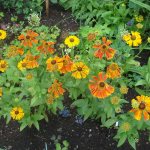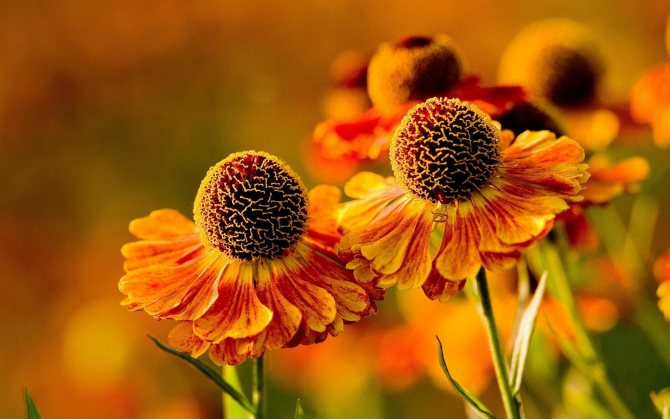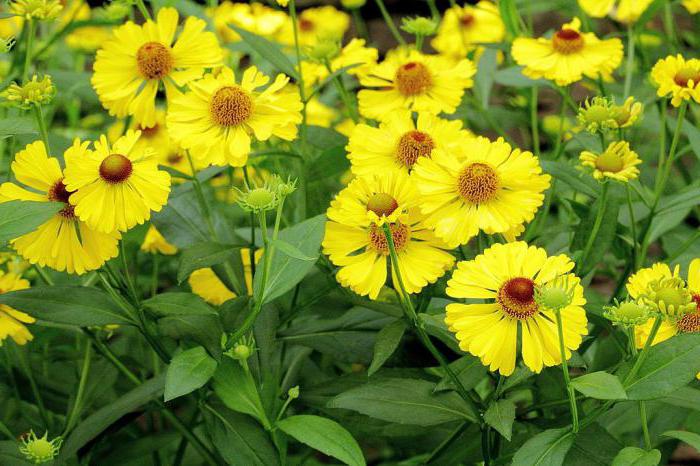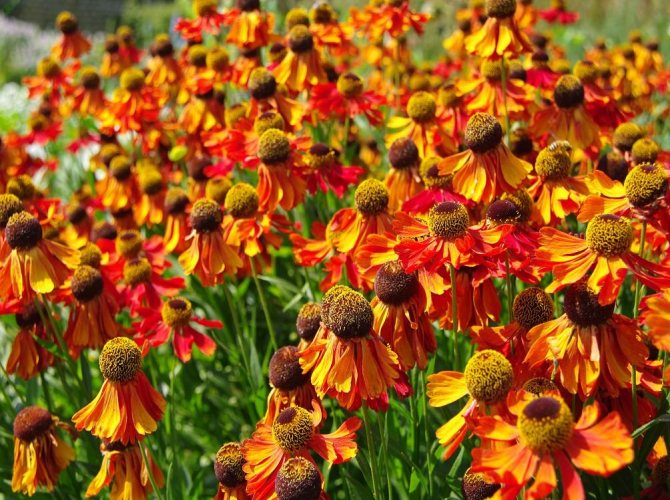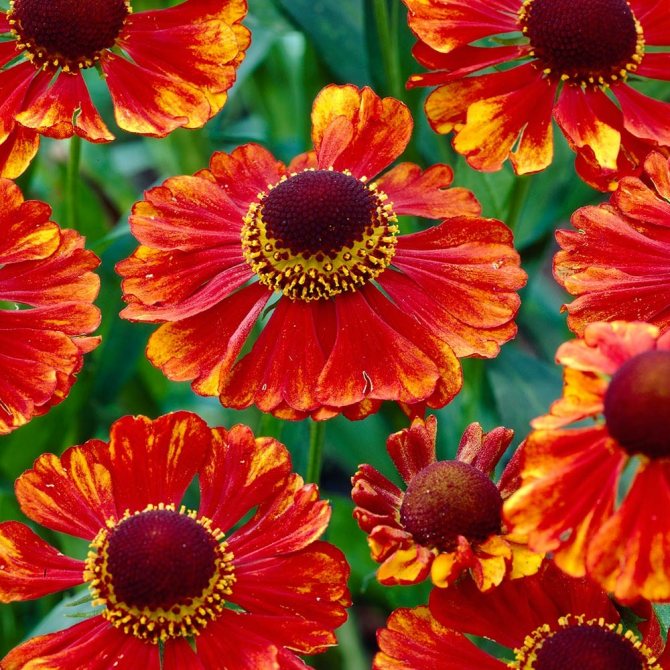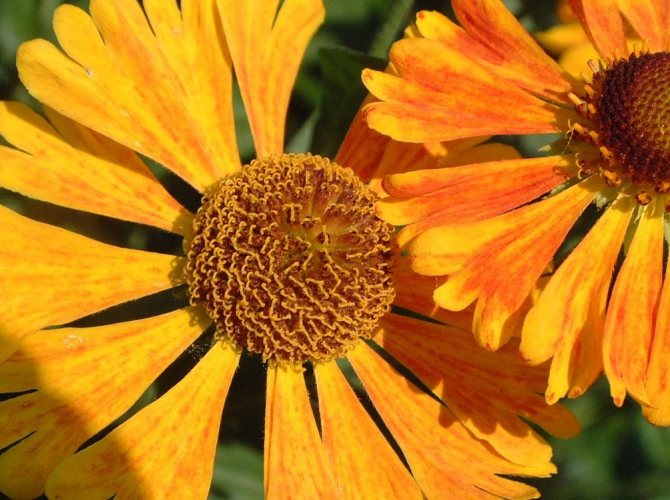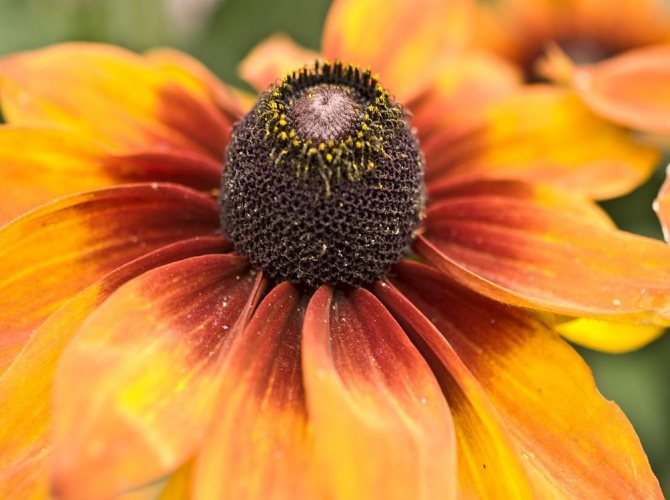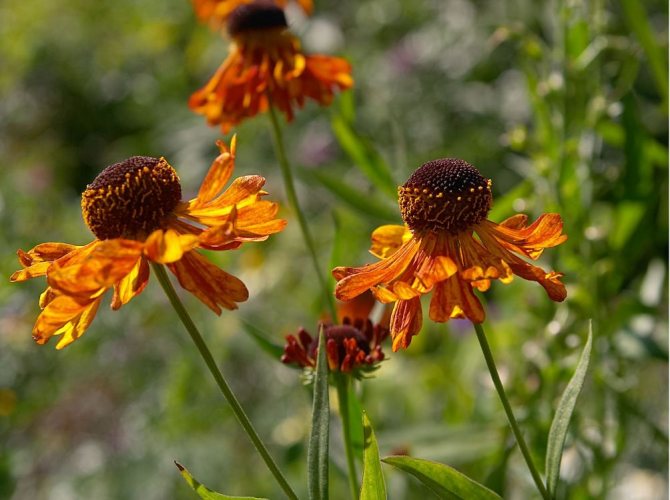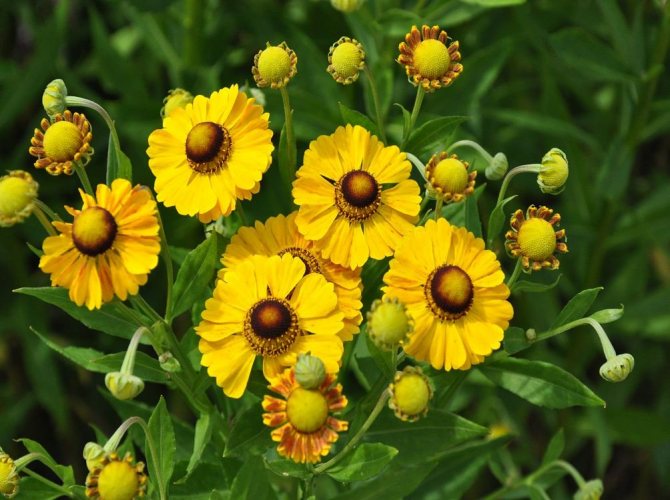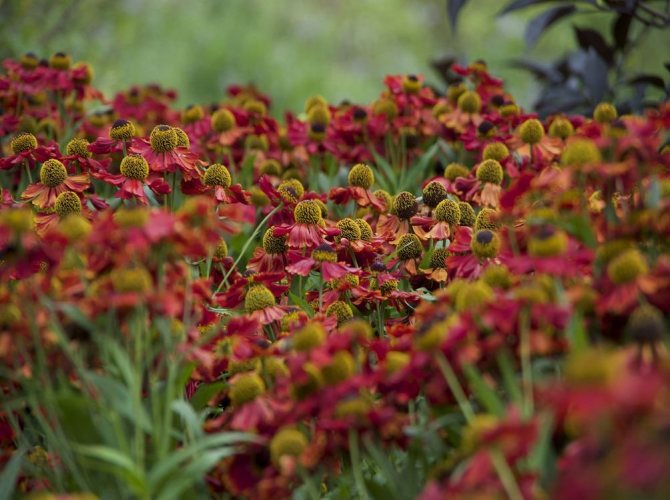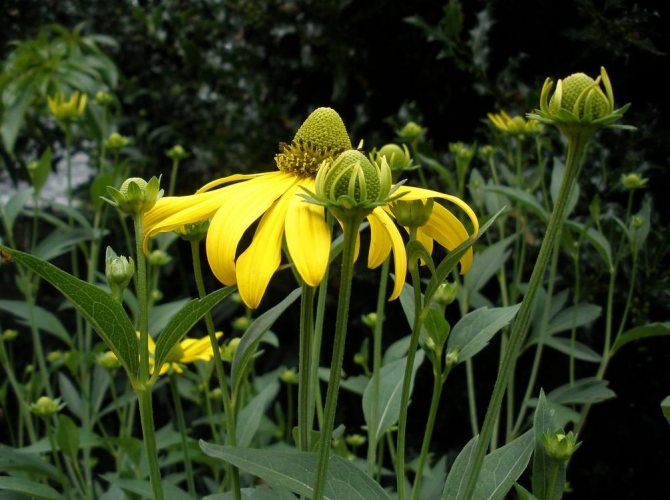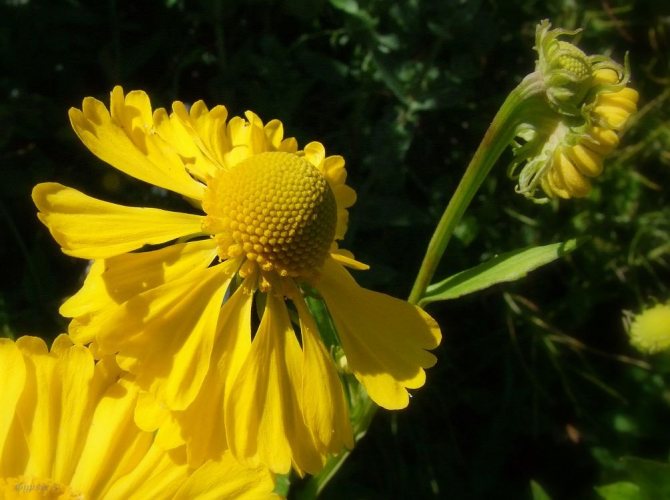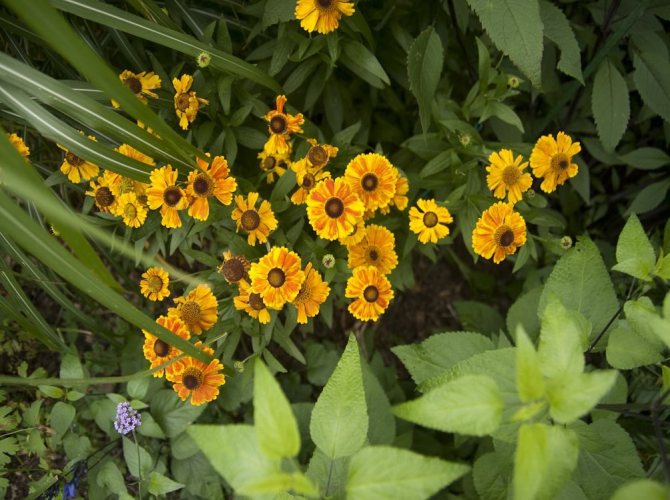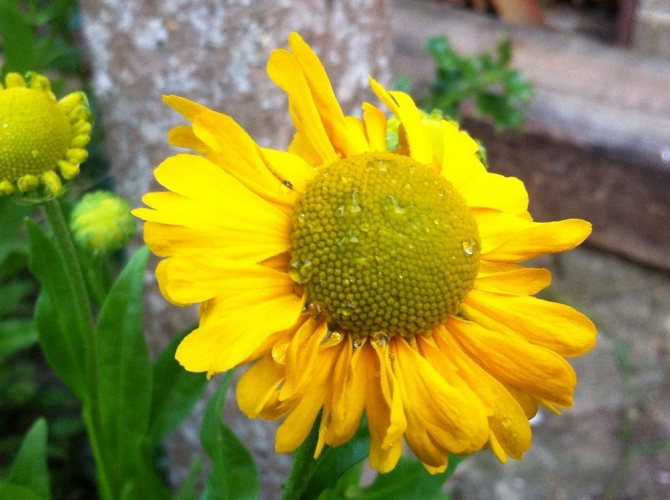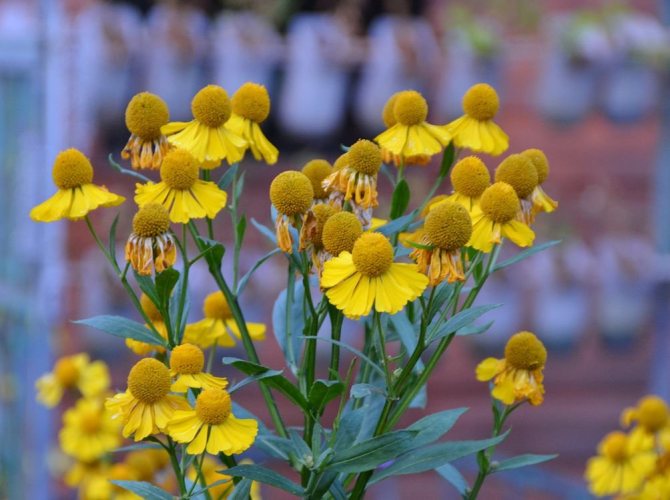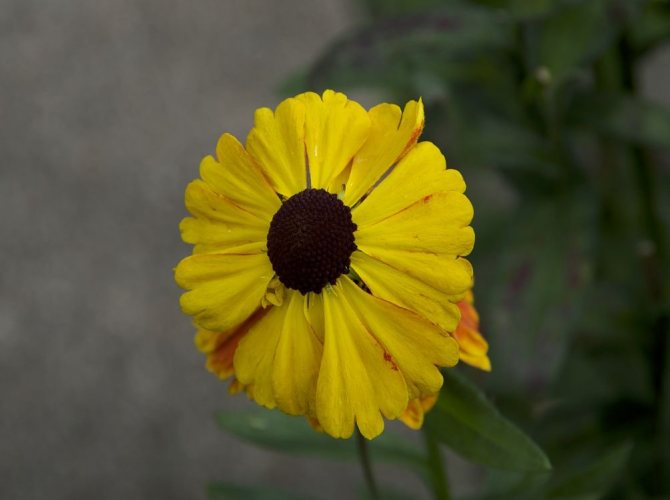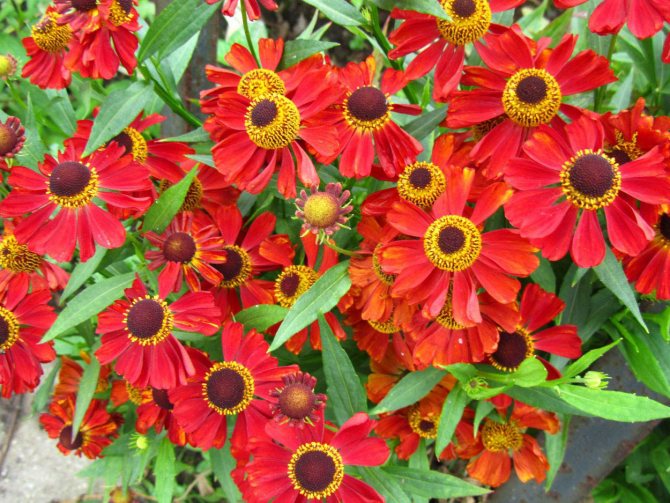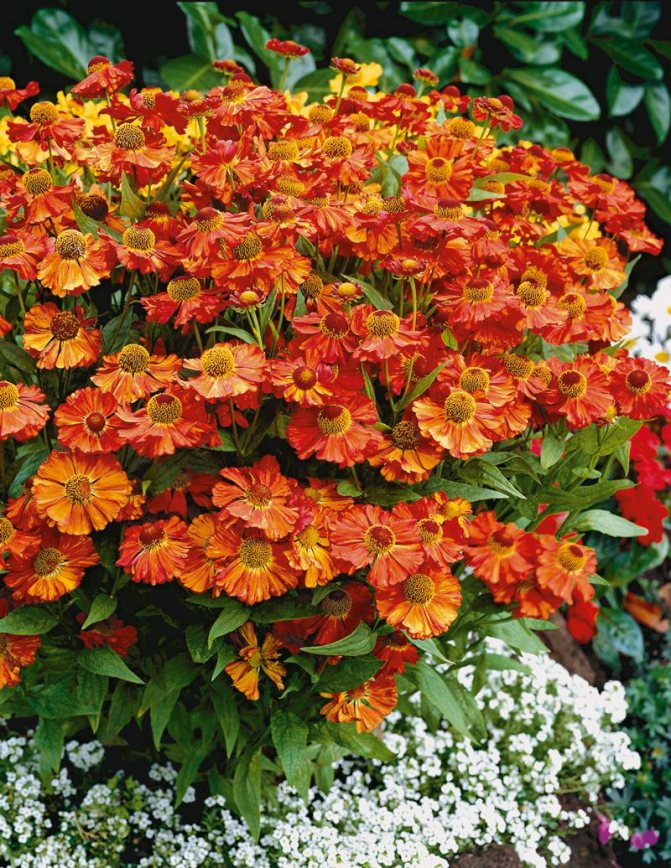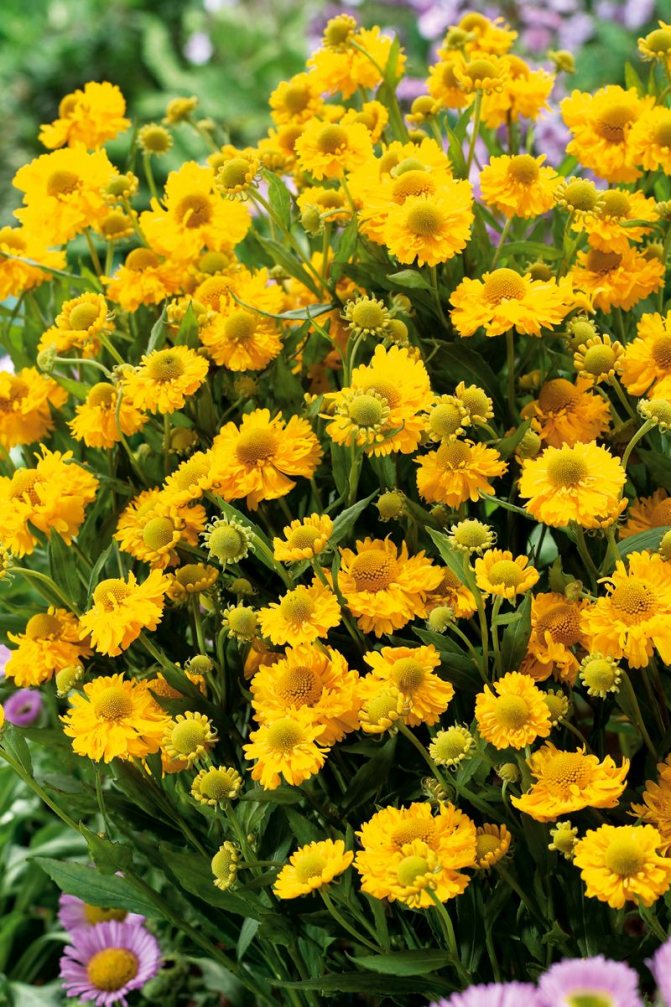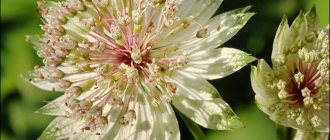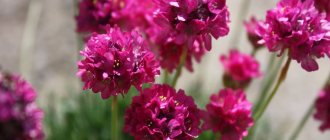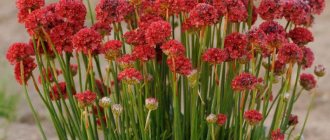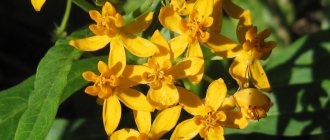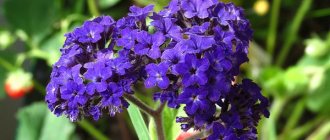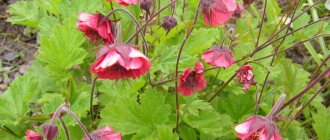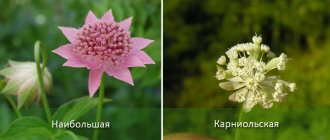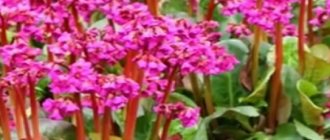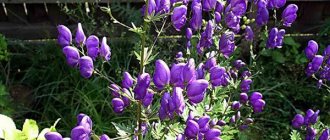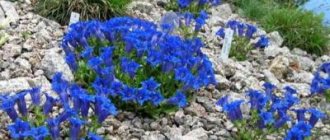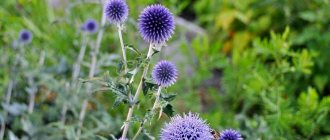This flower came to us from America. Garden varieties are called Helenium hybridum. It is a beautiful, long-flowering perennial plant, the ornamental qualities of which are undervalued, although the flower certainly deserves attention. Its charming, brightly colored flowers will be the pride of every flower bed. Flowers look especially beautiful in gardens decorated in a romantic, naturalistic or rustic style.
In this article we will tell you everything about the perennial helenium flower - planting and care, photos of varieties, features and conditions of growing, reproduction.
Description of Gelenium
For the first time, the helenium flower was discovered in the region of Central and North America. Today, more than 30 species of this perennial herb are known. Geleniums are not endowed with a long-term developed rhizome. Strong flowering stems dry out after the onset of autumn frosts along with the roots.
But during their withering away, living buds that have appeared on the ground part of the plant form a rosette of leaves with roots. It is this new rosette that forms the flowering stem for the next year. Geleniums do not have the shape of a bush, they are independent plants, closely spaced to each other.
They have straight stems, they branch upward, reaching 160 cm in height. Lanceolate leaves are arranged in the next order. They give inflorescences in the form of baskets, single or collected in corymbose plants. The outermost flowers are purple, yellow, orange or two tones, the central ones are yellow or brown. As a result, they give cylindrical achenes, slightly pubescent.
General information
Gelenium looks like a lush bushgrowing up to 160 centimeters in height. The bush itself consists of several independent shoots that grow separately, but are placed tightly. Today, botanists identify about 30 varieties and varieties of helenium.
The stems of the helenium flower have a branching structure, small thickness and decent height. The size of the sharp leaves is small, and near them there are tiny inflorescences in the form of baskets. As for the flowers themselves, they are somewhat like daisies. The color is presented by pale yellow, dark red and brownish tones and is determined by varietal characteristics. The main advantage of gelenium is its good aroma and bright color.
It is known that Gelenium does not have a perennial root system, and all the roots begin to die off in late autumn, along with the peduncles and green stems. In the underground part, a characteristic leaf rosette with a rhizome is created, from which a new flower soon forms.
Growing conditions and proper care
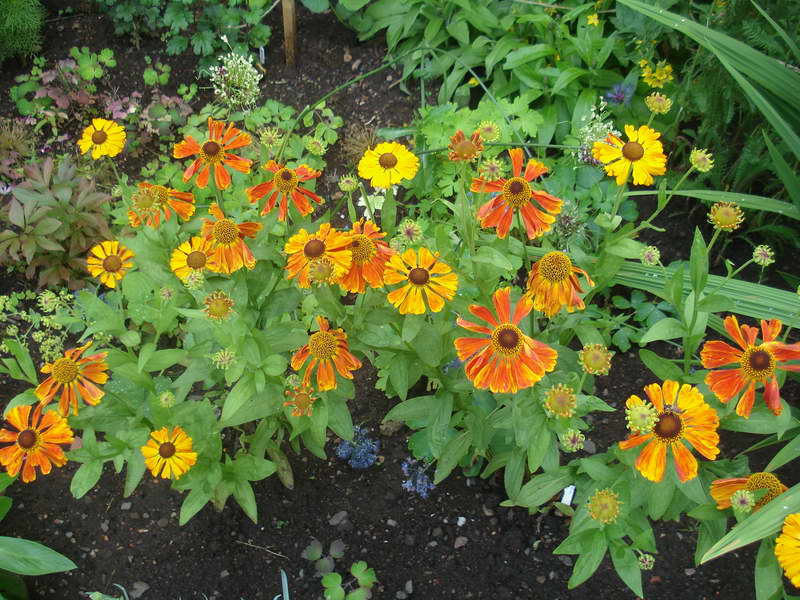
How to plant helenium in open ground photo
Beautiful geleniums prefer well-lit areas, they do not tolerate shading. To plant them, you need to select fertile soils that have a sufficient amount of moisture, a neutral level of acidity.
When planting lush heleniums in a garden, one should take into account the peculiarities of growing in a natural environment: plants prefer fertile meadow soils with a sufficient level of moisture, where forbs grow.
- Densely planted flower beds are an excellent habitat for geleniums.
- Low-growing varieties can be planted on the front of a mixborder or as curbs, tall ones look great in the background.
- Lush bushes look great as tapeworms against the backdrop of a neat lawn.
- Geleniums love regular watering because they do not tolerate droughts.
It is necessary to pay special attention to growing heleniums during the period of dry summer heat. They respond well to feeding with natural organic matter. Such procedures must be carried out three times during the entire active growing season.
After 4 years of growing gelenium in one place, you should seriously think about transplanting, because plants quickly age and degenerate. It is advisable to do this procedure in the autumn. If at the end of the summer season a blooming helenium was acquired, then before planting it, the upper part of the stem is cut off so that a height of 12 cm remains, we plant it carefully, without affecting the root system.
- Experienced gardeners know that helenium bushes can not withstand the harsh winter of the Moscow region. To provide the plant with a better chance of survival, in the winter it is better to cover the bush with fallen leaves, spruce branches or artificial covering material, and in winter it is imperative to make sure that there is snow on top, especially in severe frosts.
The outer flowering stems of helenium live the whole season, dying off for the winter, like all perennials. But, unlike everyone else, even the root neck dies off at the end of the warm season. It is renewed by the buds appearing at the base of the stem. In a snowy winter without severe frosts, geleniums winter well, but in a harsh, snowless winter they can freeze out.
- The susceptibility to cold is increased in hybrid varieties of helenium, which are especially thermophilic.
During the preparation of the plant for winter, it is worth thoroughly mulching the plant with moss or sawdust, you can cover it with ready-made lutrasil. In order for the plant to winter comfortably, you need to cut off the tops of adult plants in front of the shelter.
Plant feeding
To ensure lush flowering and active growth of plants, it is necessary to ensure their constant fertilization.
- The first time the soil is fertilized in early May, since it is at this time that the active growth of perennials begins. It is better to use urea or some liquid composition as a top dressing.
- The second time the plants are fed in order to increase the flowering volume. It is recommended to use Agricola-7 or Agricola-fantasy as a top dressing. Manufacturers indicate on the packaging how to use the formulations correctly.
- When the plant has faded, a third feeding is carried out, which is intended to prepare the plant for the winter period. To do this, you can use superphosphate or potassium sulfate.
To maintain the splendor of the flowering, small pruning of the bushes is also carried out. For this purpose, the tops of the tallest shoots are removed. Abundant flowering and development of new flowers will ensure the removal of discolored buds.
Growing helenium seeds at home When to plant
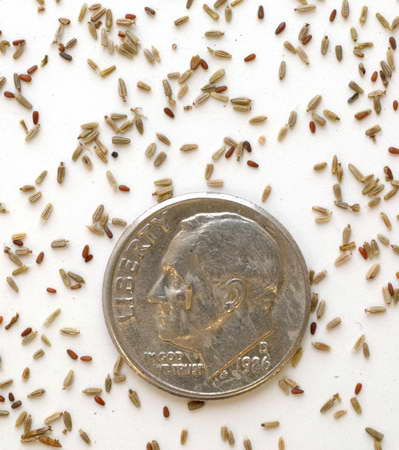

Gelenium seeds photo How to grow helenium from seeds
Planting helenium seeds for seedlings at home is very simple. You can sow as early as the twentieth of March.
- The soil is prepared loose, enriched with organic matter, peat and sand are added. But, of course, it is better not to suffer and purchase a ready-made soil mixture for flowers.
- Although the seeds are very small, it can take a little longer to arrange them further apart.
- Often they sow directly into a common container, so that they can be opened later. Leave 2-3 cm between seeds, do not save space excessively so that the seedlings do not stretch out.
- If you are patient, plant two or three seeds in separate pots, it will be easier to care for the plants, you do not need to transplant seedlings, and the flowers will come out much earlier, since we will not waste time on the survival of the sprouts when picking.
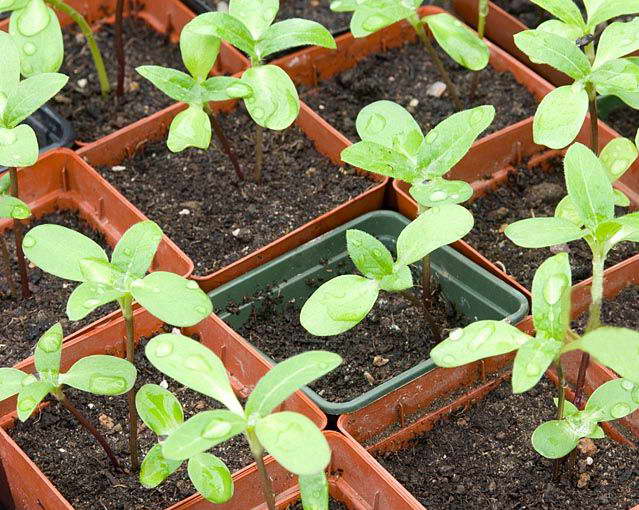

Gelenium seedlings photo What does the seedlings of helenium look like Seedlings of helenium Planting and care
- If sown thickly, when 2-3 true leaves appear, you will have to dive into prepared cups.
- We irrigate regularly, but without fanaticism: the water should not stagnate. Do not forget about the drainage holes in the bottom of the container so as not to provoke root rot or black leg disease.
- The lighting needs to be bright, the Hellenium loves light and develops well with long daylight hours. if the room is dark, do additional lighting.
- Planting seedlings begins in mid-May, if there is no night frost. Therefore, it is not superfluous to harden at the beginning of the month, taking the plants outside to get used to the sun and wind. Hardened seedlings are much stronger and easily tolerate planting in the ground.
Considering that helenium produces a good, branched bush, it is better to leave a distance of 40-50 cm between the bushes. Not so large flowers or even ground cover can be planted nearby.
Landing in open ground
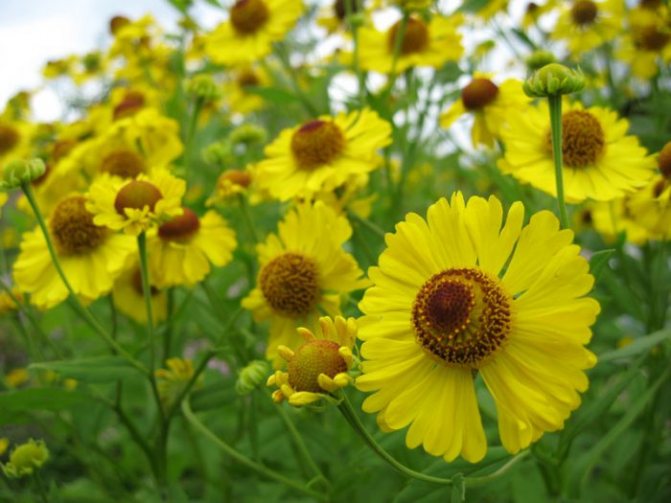

What time to plant
It is necessary to plant seedlings in open ground only when the night frosts are left behind. As a rule, this time falls on May or early June. For planting, it is best to choose a well-lit area, but you can also grow helenium in a shaded place. A light soil is best, but must be nutrient-dense, well-drained and neutral. Before planting seedlings, it is recommended to dig up the soil with compost to the depth of a shovel bayonet.
How to plant
It should be noted that the size of the planting hole should be a couple of times larger than the size of the root system. Before placing the plant in the hole, its roots must be kept in a container with clean water for several minutes. Seedlings must be planted at the same depth at which they were grown in containers. It should be remembered that at least 30 centimeters must be left between the copies, and the row spacing must be 35 centimeters. When the flowers are planted, the surface of the soil should be sprinkled with a layer of mulch (humus or peat). A plant that was grown from seed through seedlings will begin to bloom only in the second year after planting. It should also be remembered that only species are recommended to grow from seeds. Varietal species need to be propagated using vegetative methods, the fact is that flowers grown from seeds are not able to retain the varietal characteristics of the parent plant.
How to sow Hellenium seeds in the ground When to plant
Hellenium can be planted directly into the ground. Like any perennial, it is planted in autumn or early spring in order to get seedlings as soon as possible. It is enough to wait for warm weather and soil maturation. Usually this is the end of April - May... Sometimes it turns out to sow even in March, it all depends on the region. In autumn they are planted at the end of September-October.when it is already cold enough for the seeds to not sprout.
- The garden bed is prepared with loose, well-drained soil, it is better to season heavy clay soils with humus and add sand.
- The distance between the furrows is 30-35 cm.
- We sow less often so as not to break through.
- The sprouted bushes are watered and freed from weeds, loosened the soil.
- When the seedlings grow to a height of 8-10 cm, they can be replanted.
- The remaining plants should be 30 cm apart.
After flowering
Seed collection
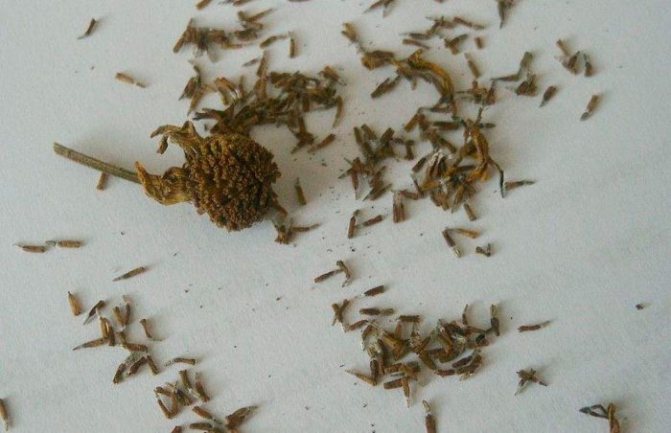

The seeds must be harvested before the rainy season begins in the fall, otherwise they will simply rot. You can find out about the maturity of the seeds by the tubular flowers that have become black and by the darkened reed flowers. However, it must be remembered that it is recommended to purchase seeds in specialized stores. The same seeds that you have collected have extremely low germination capacity, and they may also not retain the varietal characteristics of the parent plant.
For wintering, you need to cut off shoots almost to the surface of the soil, so, only cuttings with a height of 10 to 15 centimeters should rise above the soil. Then the surface of the site is sprinkled with a layer of mulch (sawdust or moss), and lutrasil is distributed over it in order to protect the helenium from a fierce or little snowy winter.
Hellenium transplant and reproduction by dividing the bush
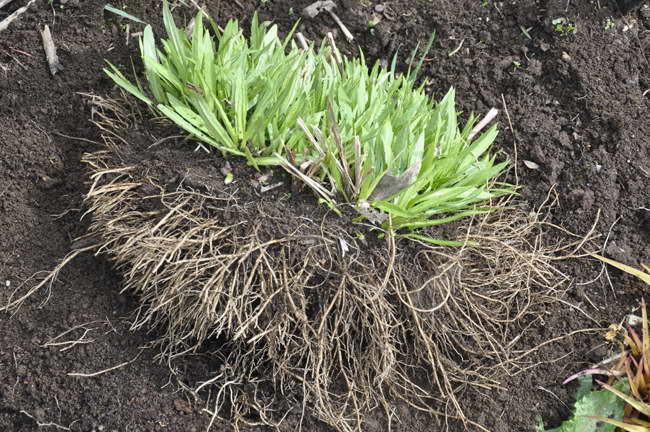

Transplantation and reproduction of hellenium by dividing the bush photo
As already mentioned, it is necessary to transplant Hellenium 4-5 years after disembarkation. A developed bush will degenerate over time to rejuvenate the plant and give space for development, and periodic division of the bush with repotting is required.
- Carefully dig in the root and get a bush with a lump of earth.
- Take a knife or shovel to cut the bush into several pieces, being careful not to hit the ground.
- They are planted in deep holes up to 30 cm, on the bottom of which humus is poured.
- The planting level remains the same without deepening the root collar. Keep in mind that the earth will settle, strive so that later the roots do not end up on the surface, which is also very bad.
- Water abundantly to moisten the soil to the full depth of the hole.
Sometimes they do this: they dig in a bush around the edges, separating its parts, and leave some untouched. Since the bush has been split, there will be room for new root buds to grow and the plant will rejuvenate. And the separated delenki are planted in a new place.
Use in the garden
Tall lush bushes with large and bright flowers will impress you. Such a plant should occupy central positions in the flower garden or be located in solo group plantings in the middle of the lawn. Low-growing varieties are used to frame flower beds, as well as in mixborders. The best neighbors in a flower garden for gelenium will be delphiniums, asters, marigolds, stonecrops, vervains, geychera and phlox.
Gelenium can also be used to make bouquets. However, the buds on the cut shoots will no longer open. A fully blooming plant will stand in a vase for a long time.
Gelenium in landscape design
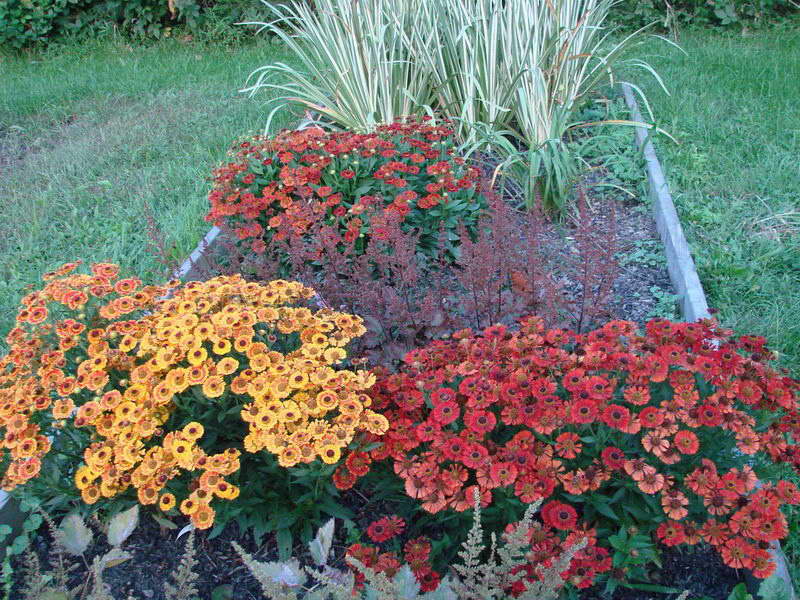

Gelenium photo of flowers seedlings when to plant Gelenium in the garden photo
Gelenium is planted in large flower beds in the background, near ornamental shrubs, in groups or singly. They are used to decorate the fence of buildings. High helenium perfectly coexists with autumn asters.
Their inflorescences look great in bouquets and compositions, they are cut off completely blooming, since water does not affect their blooming of buds.
Landing and seat selection
Gelenium should be planted in a well-lit area or in partial shade. The best time to plant outdoors is early June. The soil should be nutritious and light. It is necessary to choose a composition with neutral acidity. Lime is added to too acidic soils.
Even before planting, it is recommended to thoroughly dig up the ground, break up large clods and add compost. The planting pits are made twice as deep as the seedling rhizomes. The roots of each plant are dipped in water for a few minutes beforehand. The distance between flowers should be 30-40 cm. For high varieties, it is increased to 70 cm. After planting, the soil should be tamped and mulched with peat. In the first year, the plants grow green mass and form a dense leaf rosette. Flowering begins no earlier than the second year.
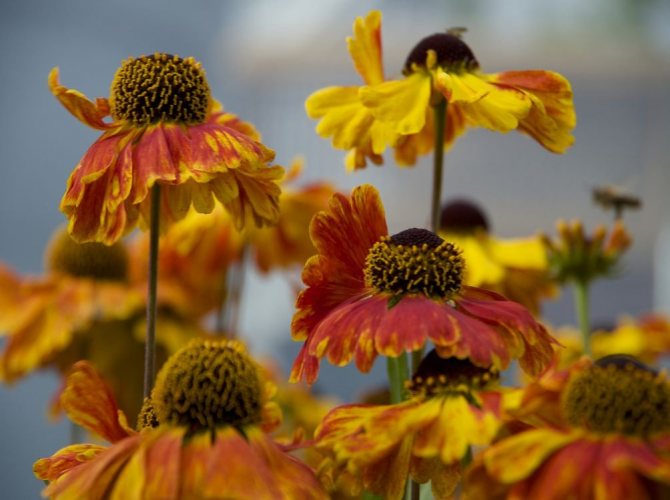

Types and varieties of gelenium with photos and descriptions
Hegenium autumn helenium autumnale
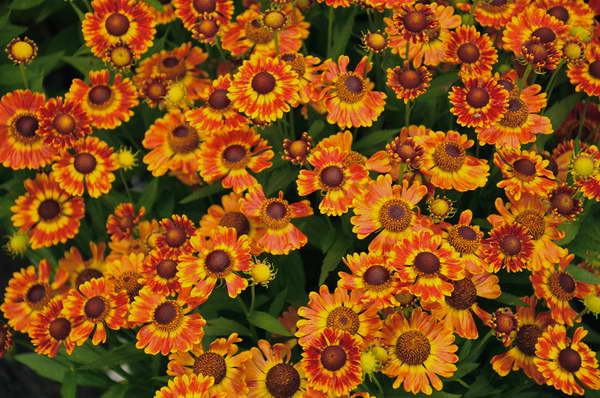

Helenium autumn Fuego Helenium Fuego planting and care in the open field photo
Autumn Gelenium, cultivated since the 17th century, is the most widespread. The abundant late flowering is considered to be the distinguishing advantage of this flower. The bushes of the autumn variety of helenium have a columnar shape. Strong stems of this variety can rise up to 2 m in height.
The upper part is strongly branched. Each branched part ends with a beautiful golden flower, a basket with a diameter of 6 cm.As a result, each stem can have up to several hundred flowers. The autumn variety blooms in early August, beautiful flowering continues for another month, the seeds are fully ripe by October. Currently, there are many unpretentious varieties of this flower that are excellently used in landscaping.
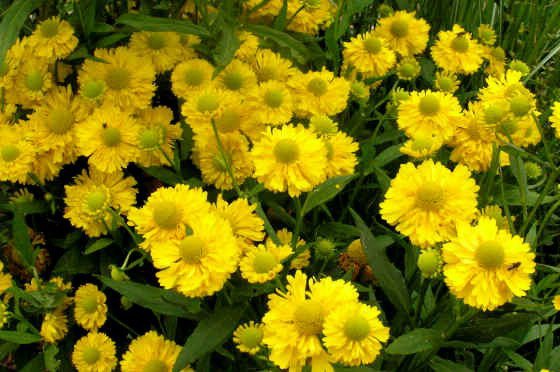

Autumn Gelenium Double Trouble Helenium Double Trouble planting and care photo
Varieties with a yellow marginal flower color are very popular. Among them is the undersized Magnificum, reaching only 80 cm in height. Its middle is classically yellow, it pleases with lush flowering in late July - early August.
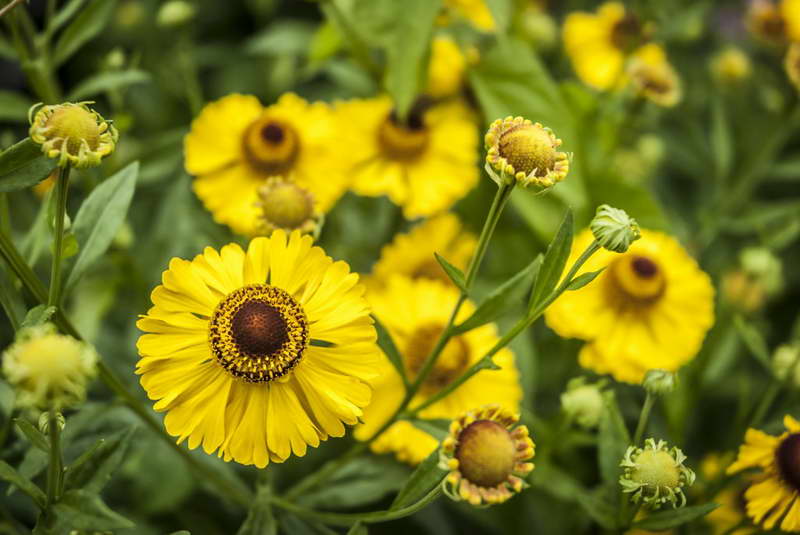

Gelenium Sunrise lemon Gelenium growing and caring for a photo of flowers in the garden
Medium-tall Gartenzonne stretches up to 110 cm, gives lush baskets with a diameter of 6 cm, the middle of the flower is brown. Flowering begins in late July.
The adorable Katarina is 140 cm high, and the middle of her flower is also brown. Lush flowering pleases from mid-August.
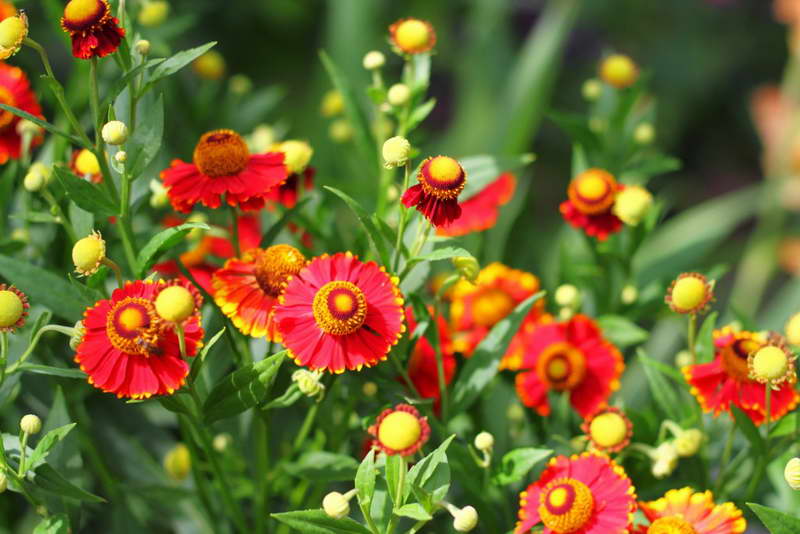

Gelenium autumn sunrise red What does helenium look like photo how to plant helenium
The magnificent variety Moorheim Beauty reaches 180 cm in height, the middle of the flower has a yellow-brown tint. Abundant flowering also begins in mid-August.
They also bred varieties with a red color of flowers. Among them, it is worth noting the medium-tall variety Di Blonde, which has a developed dense bush up to 170 cm high. Its marginal flowers are red-brown in color, the middle is also brown. This variety begins to bloom in mid-August.
An interesting low-growing variety Glutauge, it gives baskets with a diameter of 6 cm, the core of the flowers is red-brown.
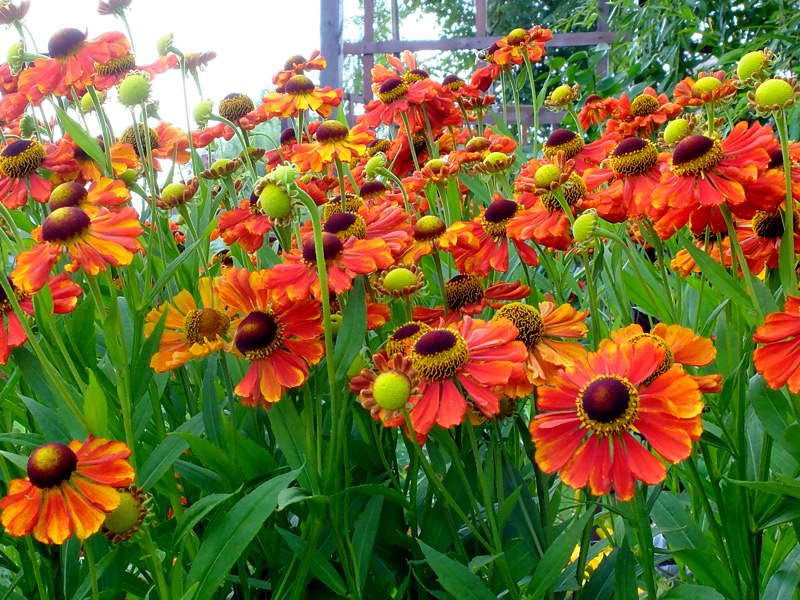

Gelenium Moorheim Beauty Gelenium autumn varieties garden flower helenium photo in the garden
The natural environment for the distribution of heleniums is wet, swampy areas. The roots of the plant are superficial, they are poorly developed. The bred varieties of autumn helenium are cultivated in illuminated areas. The garden soil for them must be provided with proper watering. Sufficiently high grades are tied to wooden stakes. Geleniums have a high growth rate, after 3 years of intensive development, it gives up to 30 new stems.
The plant itself also ages quickly, as it grows in breadth. It is for this reason that in the 4th year of development it is necessary to divide the bush and transplant to a new place. The optimal time for the next transplant is early spring, when the dug out plants easily disintegrate into separate outlets, 2 pieces of them are planted in prepared places.
Strong helenium Chupa Gupesa Helenium hoopesii
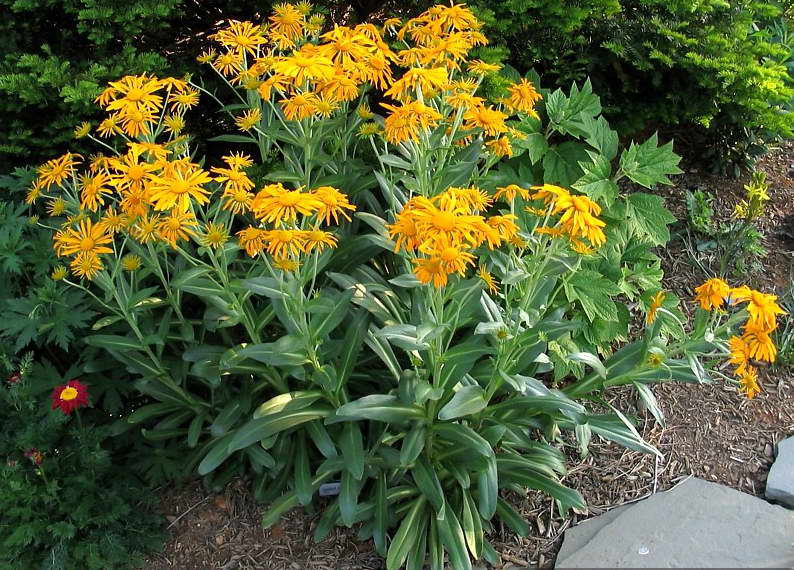

Strong helenium gupesa Helenium hoopesii photo of flowers in the garden planting and care
This plant grows comfortably in rocky terrain. It has a developed rhizome, large basal leaves, strong stems. Gelenium gupesa gives rather large baskets with a diameter of 10 cm, its flowers are orange in color. This variety has a long flowering period of up to 40 days, starting in July. Then it begins to bear fruit, has breeding methods similar to autumn helenium.
Helenium hybrid


Gelenium bright beauty Garden flower helenium Flowers perennials helenium
This category includes all garden heleniums obtained by crossing the first two forms. They differ in height, shape, color of flower baskets, and have different flowering periods.
Among them, it is worth noting the high variety Gartenzonne, growing up to 130 cm in height, with inflorescences up to 3.5 cm in diameter. The color of the flowers is from reddish-yellow to yellow-brown. Lush bloom is observed from July.
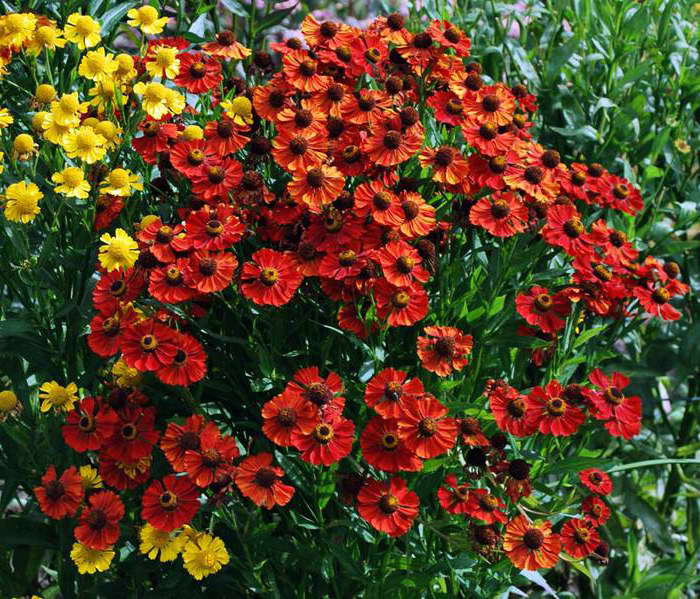

Gelenium hybrid Rubinzwerg Rubinzwerg red helenium perennial photo of flowers planting and care
The medium-sized variety Goldlaktswerg stretches only up to 100 cm. It gives inflorescences of a compact shape, up to 4.5 cm in diameter. The color of its reed flowers is brown-orange, with yellowish tips.Abundant flowering begins in July.
Also in the culture, the Gelenium variety Rothaut is widespread, capable of developing up to 120 cm in height. It is capable of producing inflorescences up to 4.5 cm in diameter. The color of the reed flowers is intensely brown, the tubular inflorescences are yellow-brown in color, lush flowering is observed from July.
Varieties
There are many attractive garden varieties of helenium. Below is a small grouping of varieties by:
- color of flowers;
- the height of the bush;
- flowering period.
Bright yellow
- Canaria (Canaria) - a variety with yellow, double outer petals and a yellow center, 1.5-1.7 meters high;
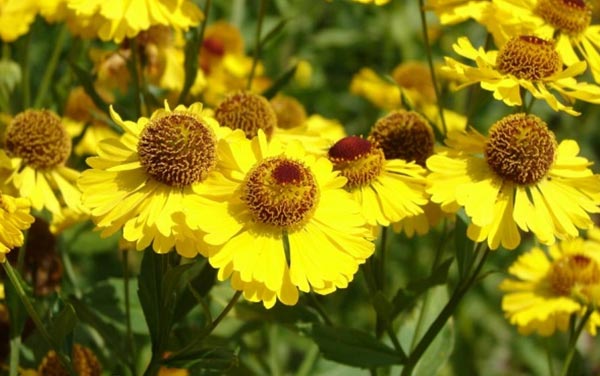

- Double Trouble (Double Trouble) - a variety with yellow outer petals and a yellow, yellow-green center, height 1.7 meters;
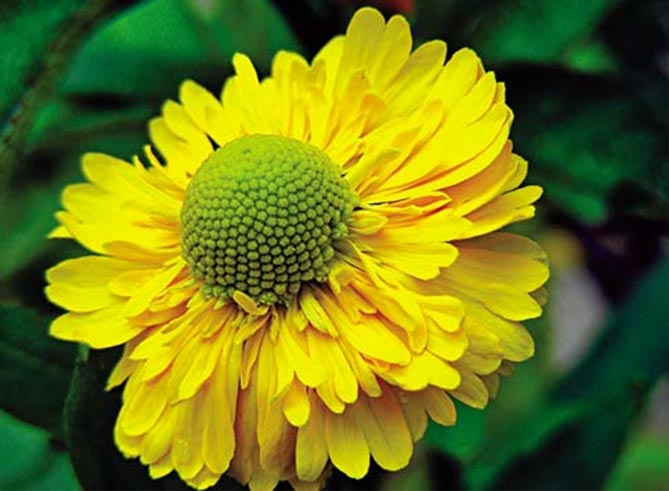

- Goldrausch - with yellow petals and a brownish-yellow basket, height 1.5 meters;
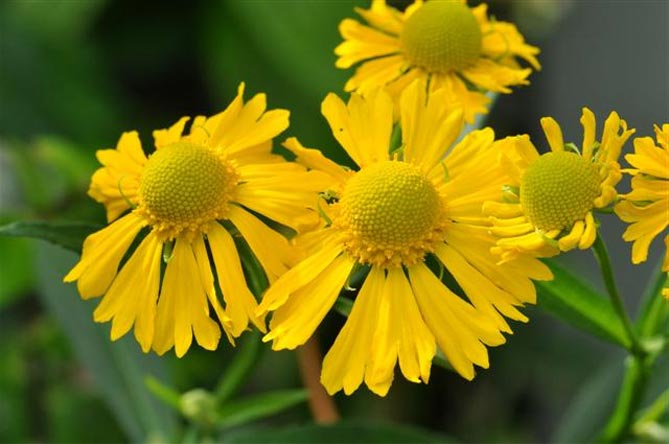

- Bishop (Bishop) - with yellow petals and yellow-brown baskets, bush height 90 cm.
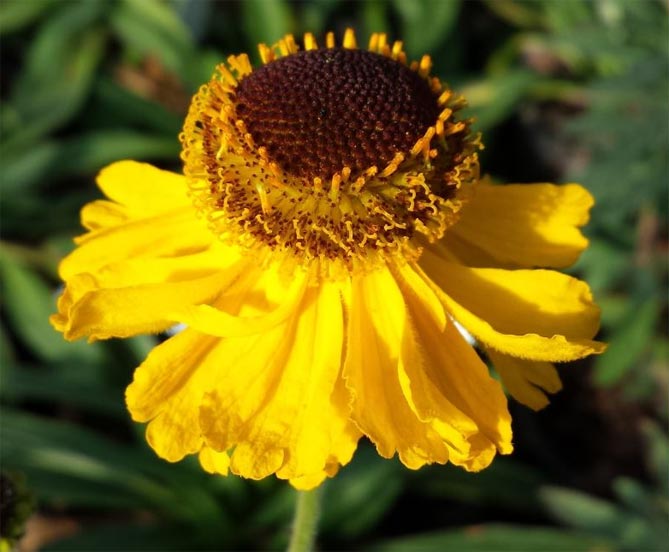

Orange or reddish brown
- Moerheim Beauty - flowers with orange-red petals and a brown-red basket, helenium height - 0.8 meters;
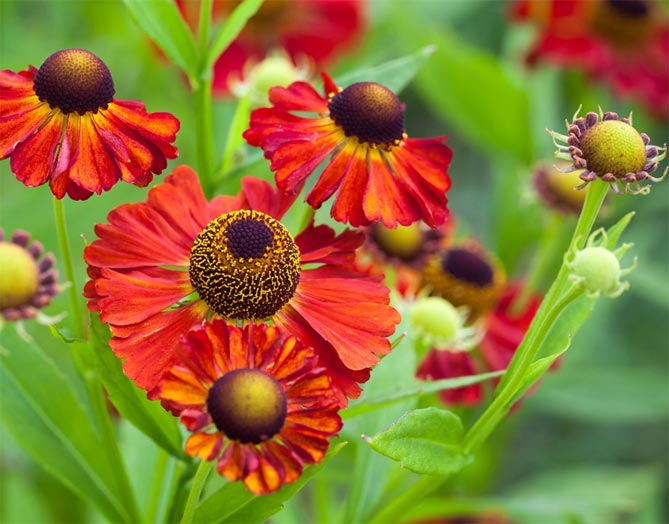

- Rubinkuppel - almost red petals and yellow-brown, not very protruding small basket, 1 meter high;
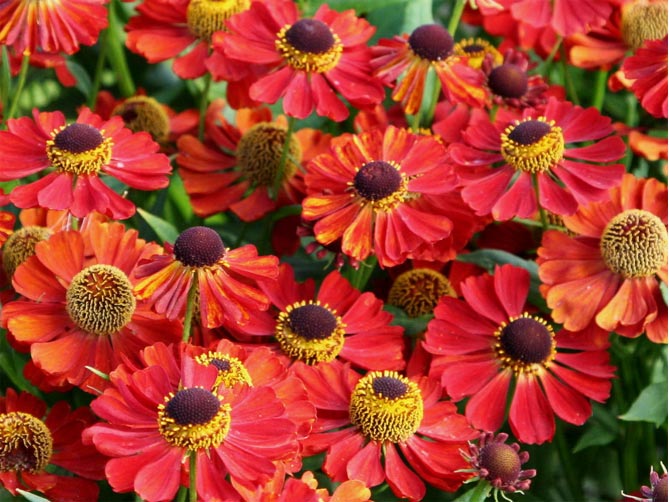

- Rubinzwerg - Gelenium suitable for cut flower, for planting in groups, red flower with yellow center, flowering time July-September. Green leaf, bush height 50 cm, requires high humidity, sunny position, permeable, fertile soil.
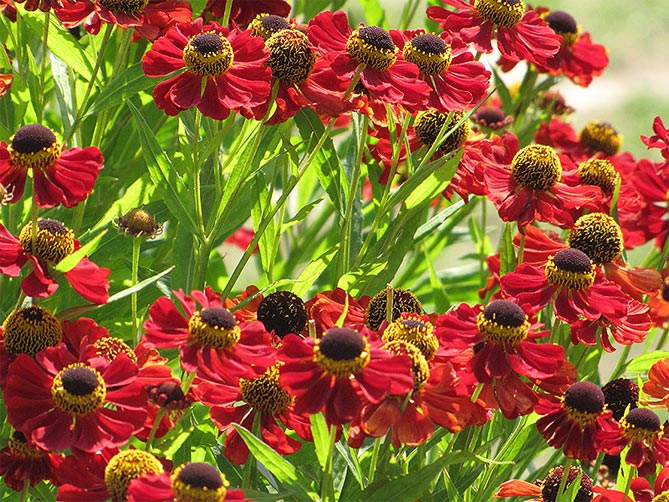

Bicolor
- Fursigel (Feuersiegel) - yellow-red petals and a brown basket, helenium height 90-120 cm, with multi-colored flowers;


- Flammenrad (Flammenrad) - variety with yellow-orange petals, height 1 meter;
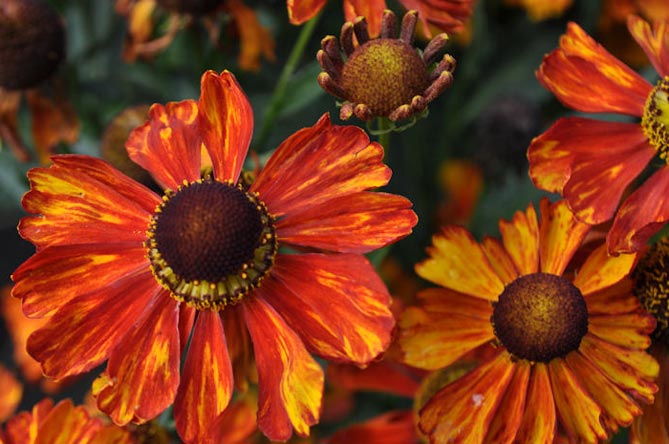

- Rauftopas (Rauchtopas) - with yellow petals in the upper part, in the lower part - orange, brown baskets, height - 1 meter.
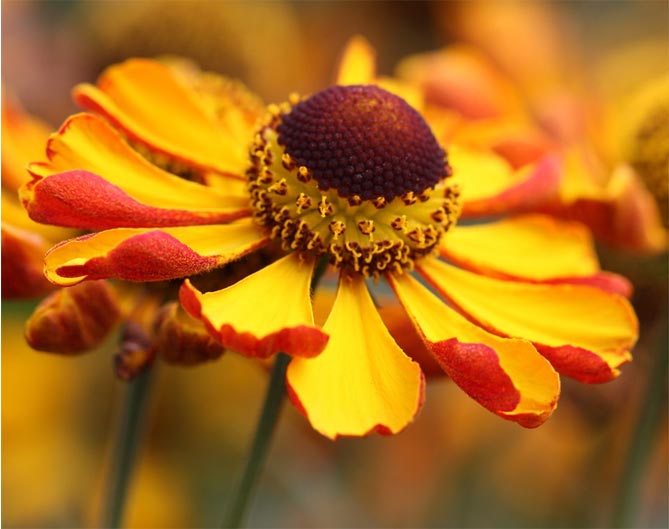

Low and compact varieties
- Moerheim Beauty - red petals, brown center, 80 cm high;
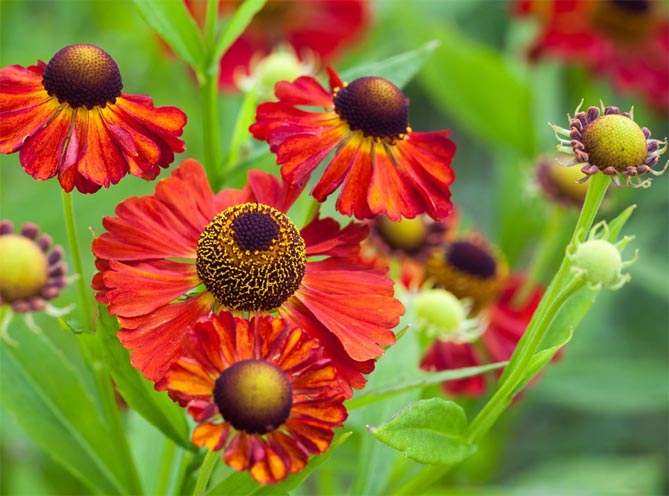

- Crimson Beauty - orange-red variety, 60 cm high;
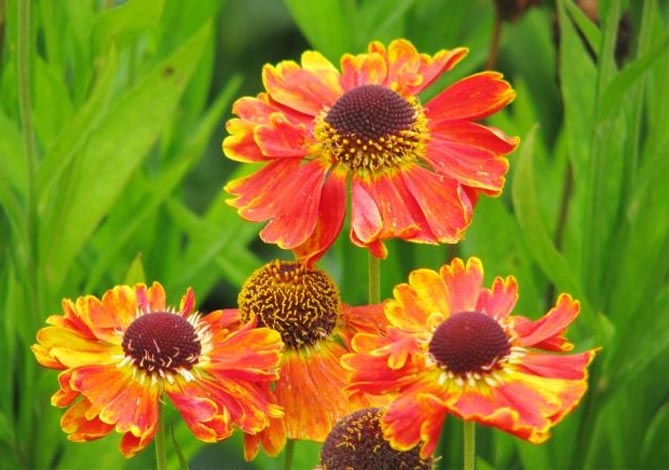

- Golden Jugend - yellow helenium 80 cm high;
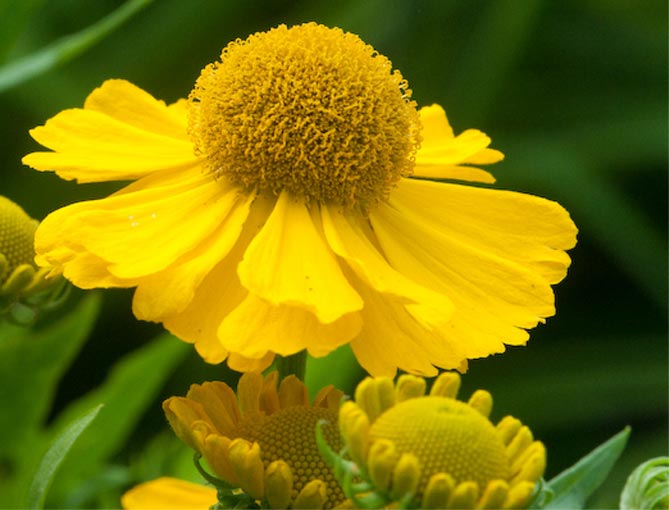

- Red Army (Red Army) - with red petals and brown baskets, the height of the perennial helenium is 60 cm.
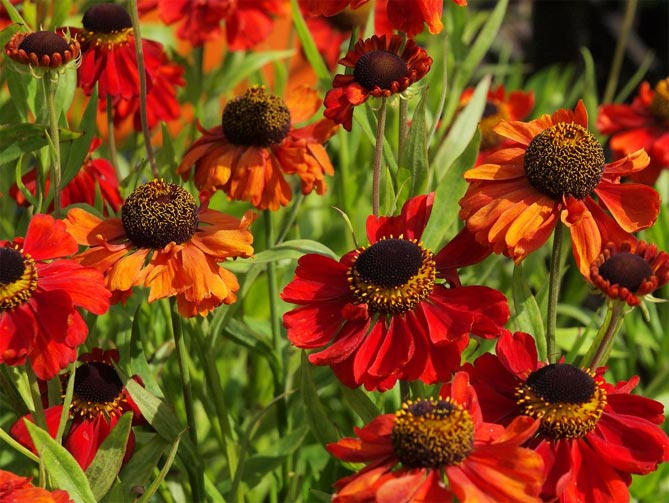

The earliest blooming from June to mid-August
- Moerheim Beauty - with copper-red, lenticular, tubular-brown flowers, plant height 70-120 cm;
- Pumilum Magnificum - helenium with golden yellow, lichen, tubular flowers - yellow, reaches a height of 60-80 cm;
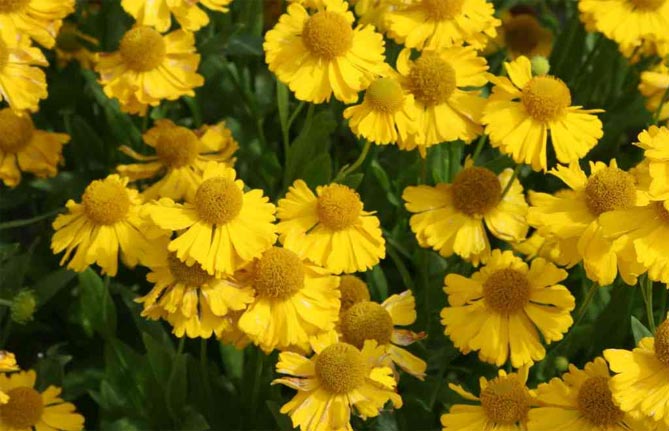

- Waltraut is a perennial variety with orange-yellow, lenticular, tubular-brown flowers, reaching a height of 80-100 cm;
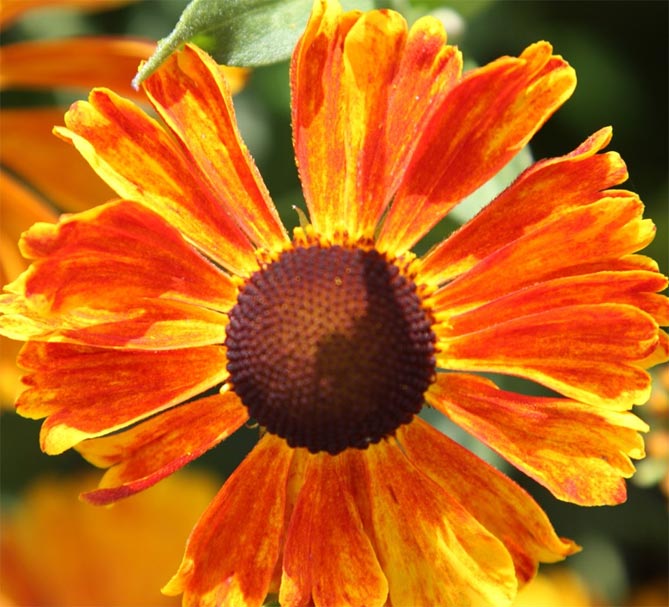

- Wesergold - with yellow, bundle, tubular-brown flowers, shoot height 55-115 cm.
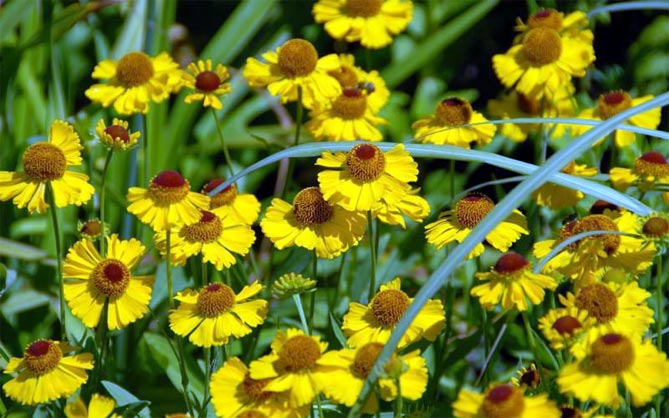

Medium flowering (late July-August)
- Autumn Gelenium (Autumn Lollipop) - perennial yellow-deciduous variety with yellow-brown tube flowers, helenium height 60-90 cm, blooms until September;
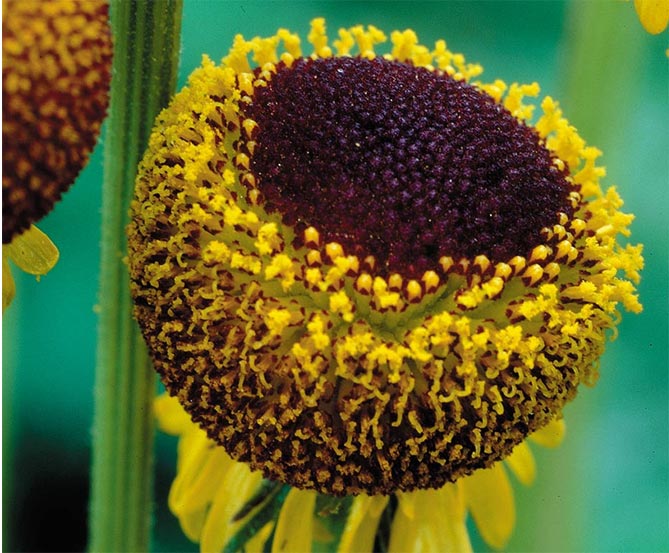

- Biedermeier (Biedermeier) - red flowers with a yellow frame, tubular-brown, the plant reaches a height of 100-165 cm, flowering until the end of August;
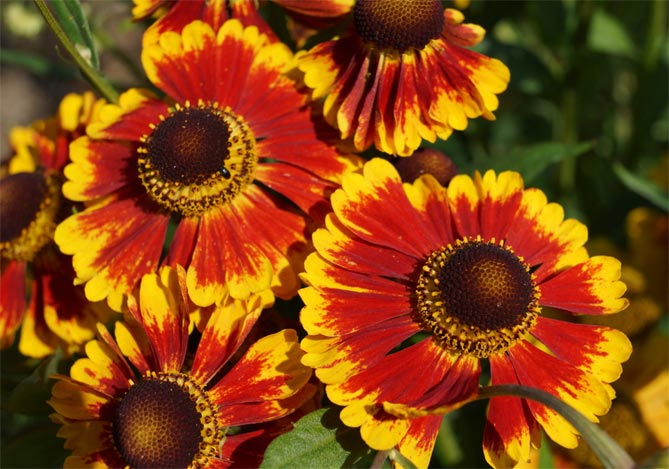

- Goldrausch (Goldrausch) - a perennial variety with golden yellow reed, tubular dark brown flowers, plant height 140-150 cm, bloom until the end of August;
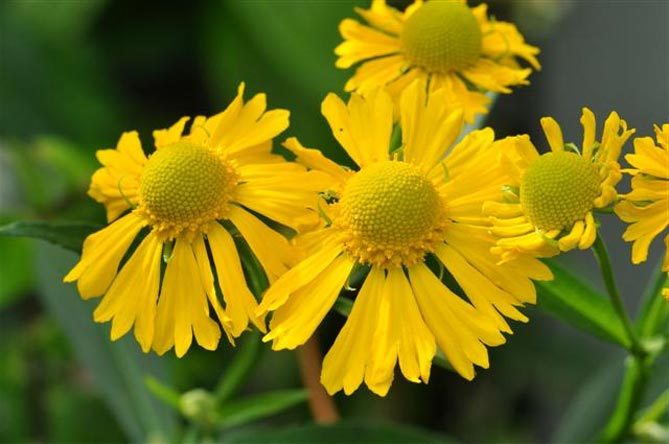

- Helena group - offered in yellow and red-brown tones, plant height 50-120 cm, bloom in the first year when propagated from seeds, inflorescences decorate plants until October;
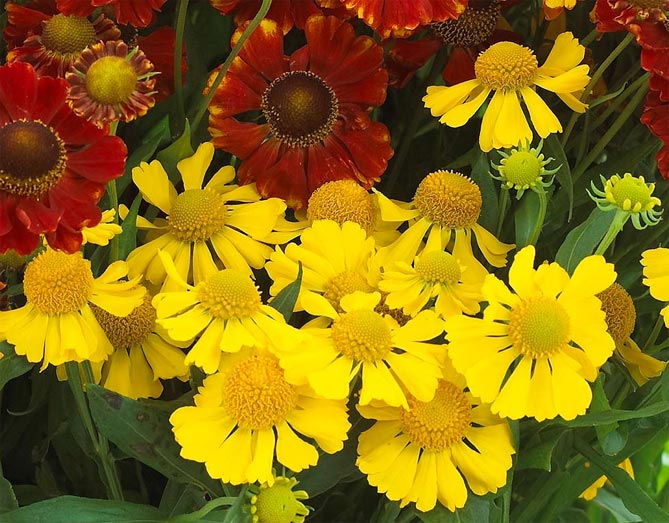

- Mariachi group Mariachi - a perennial characterized by a dense bush, blooms from July to September, available in four varieties: Fuego, Siesta, Salsa, Sombrero.
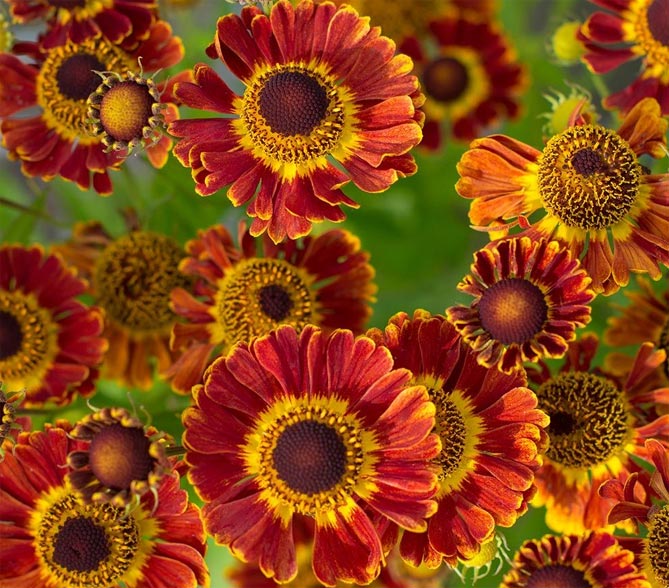

Late flowering varieties - August-September
- Bandera (Bandera) - red flowers with a yellow frame, tubular yellow-brown, plants grow up to 40-50 cm, bloom until September;


- Baudirektor Linne is a perennial variety with red, lenticular, tubular-brown flowers, plant height 100-120 cm, flowering until early September;


- Wildform - with yellow inflorescences, grows to a height of 80-150 cm, blooms until October.
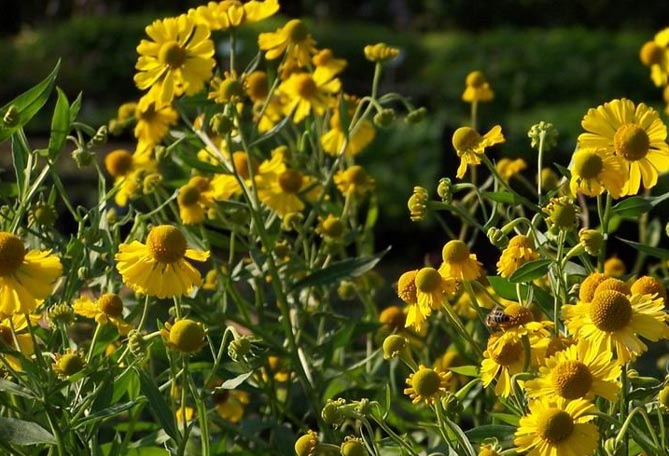

Gelenium in the photo
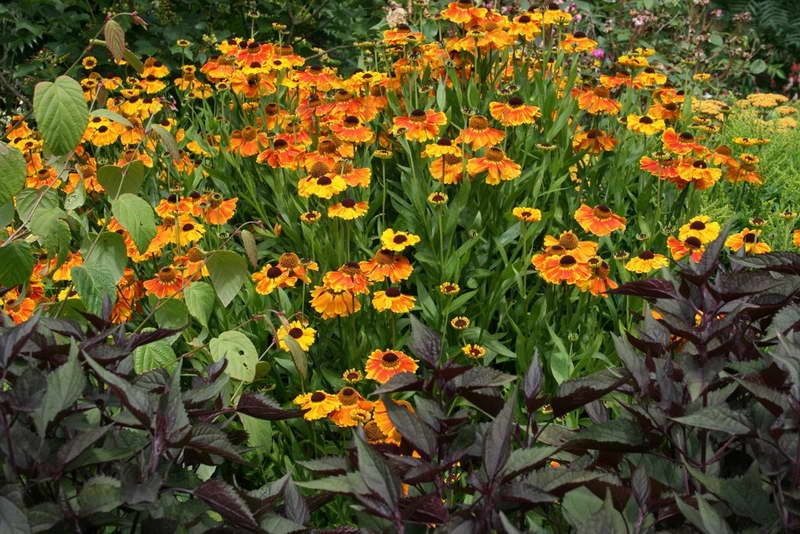

Gelenium flower growing Gelenium when to plant Gelenium in landscaping photo mixborder
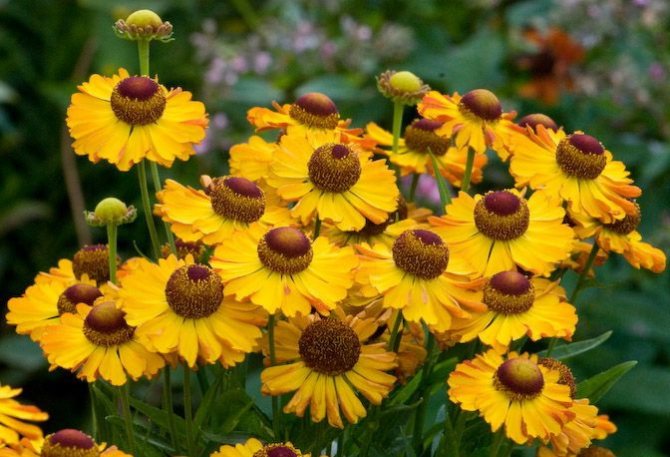

Gelenium autumn photo Planting helenium in the ground
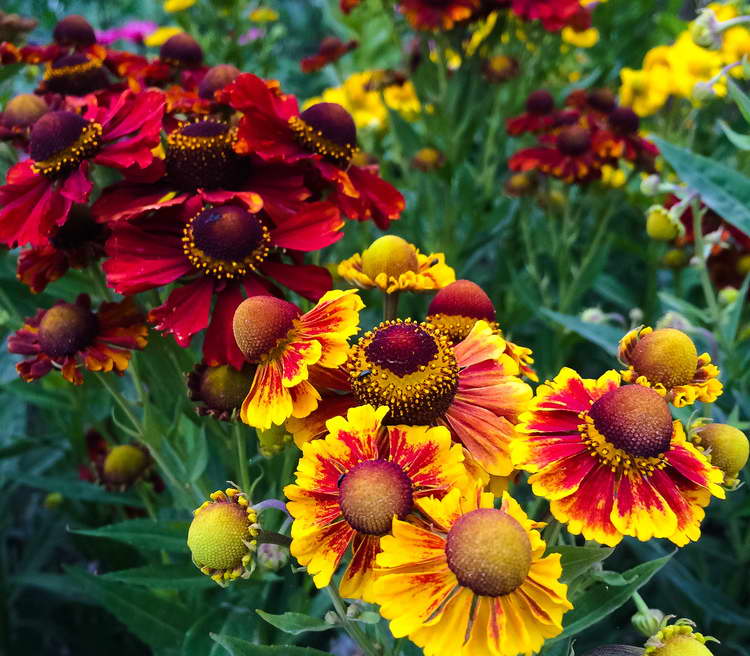

Perennial autumn flower helenium Helenium autumnale description and photo Planting and care
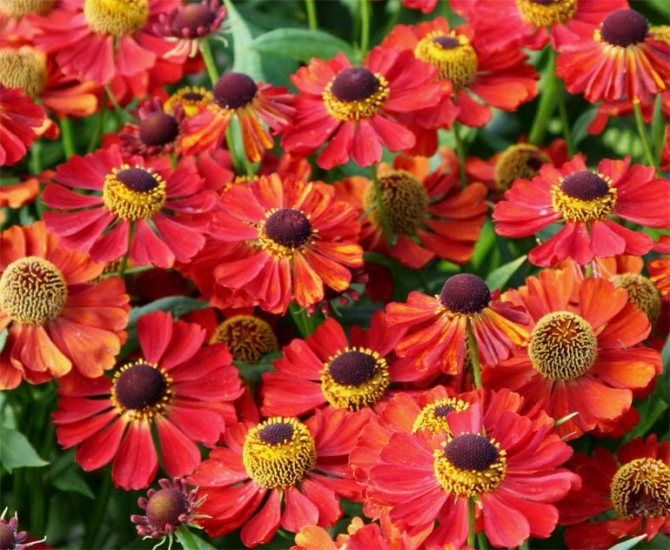

This flower came to us from America. The garden varieties are called Helenium hybridum. It is a beautiful, long-flowering perennial plant, the ornamental qualities of which are undervalued, although the flower certainly deserves attention. Its charming, brightly colored flowers will be the pride of every flower bed. Flowers look especially beautiful in gardens decorated in a romantic, naturalistic or rustic style.
In this article we will tell you everything about the perennial helenium flower - planting and care, photos of varieties, features and conditions of growing, reproduction.
Demanding environmental conditions
Despite the fact that helenium is considered not demanding on environmental conditions, this fiery flower also has its own whims.
It can withstand a lot, but not shading. It is necessary to plant any variety only in areas where the sun's rays illuminate the earth all day.
If, nevertheless, there is a wall or a fence on one of the sides, then helenium can grow here and bloom beautifully, but for this it must be located to the south, south-west or southeast of the fence.
Love for the sun in this flower is combined with a dislike for excess moisture. For this reason, helenium is best placed in elevated areas or simply well-drained areas.
This plant needs fertile soil, with a lot of organic matter. He does not tolerate heavy and acidic soil.
Before planting gelenium, it is recommended to add not only manure to the soil, but also leaves of trees or grasses. This will create the effect of loosening the soil, which will also optimize its moisture regime.
Description of the species
Perennial hybrid helenium is one of the most common species of the genus helenium from the Asteraceae family. The plant forms a large, strong bush with sprawling shoots.
Table. The main characteristics of gelenium
| Characteristic | Description |
| Height, shape | The plant grows to a height of 1.5-2 meters, has thin, highly branched shoots, a lush shape. |
| Leaves | Green, lanceolate, glandular spotted, dentate. The foliage dries out when the plant begins to bloom, it may have a lot of dry leaves, but this is not a problem - due to the height of the bush, helenium is usually planted in the back of the flower beds. |
| Height | Plant growth is fast, shoots often bend, fall to the ground, a garter to a support is needed. |
| Pruning | To delay flowering for about 2 weeks, part of the stems of the plant is cut in May-June, the cut off shoots are used for reproduction. |
| Bloom | The flowering period of helenium is long (June-October). The first flowers appear at the ends of the shoots in June and develop continuously until late autumn (end of flowering - October). A single flower appears at the top of each shoot with a strongly protruding, almost round flower basket and small, slightly curled petals, giving the appearance of a small, colorful fan. |
| Inflorescence | Flower baskets 3-5 cm in diameter, edges are yellow, yellow-brown or brown-red, at the end of the petal there are 3 separate cloves. Tubular flowers of yellow or brown color are compact, forming a dome-like dome inside the inflorescence. There are varieties and varieties with yellow, red, brown, orange stripes. Color, height, size of flowers are highly dependent on the variety. |
Be careful! Plant geleniums away from small children, the plant causes skin allergies and poisoning.
How to choose planting material
It is necessary to buy helenium seeds in bags in permanent special stores or on the Internet. The package should be made of thick paper, it has a clear photo of the flower and instructions written without errors and corrections. Pay attention to:
- manufacturer's company name,
- logo and contact details,
- the name of the flower in Russian and Latin,
- description of the plant,
- mass or quantity in pieces,
- TU, GOST, OST (laboratory test),
- shelf life.
It is advisable to purchase with a small margin, not everyone can give 100% germination.
Popular varieties:
- Rothhaut,
- Bruno,
- Helenium hybrid,
- Low autumn helenium,
- Gupes,
- Cockade,
- Ruby gnome.
Growing and care
Gelenium flowers are beautiful, extremely decorative and grow easily. The plant is perennial, frost-resistant, tolerates planting in open ground, easy care.
Soil requirements, positions
The requirements for growing helenium are as follows:
- position - grows better and blooms more beautifully in sunny or slightly shaded positions;
- soils - fertile, humic, permeable, moderately moist substrates are needed;
- frost resistance - plants are quite resistant to low temperatures, do not require winter shelter, but some varieties need to be protected for the winter.
Attention! Gelenium does not develop well on impenetrable clay, poor sandy soils, and soil that is flooded in winter.
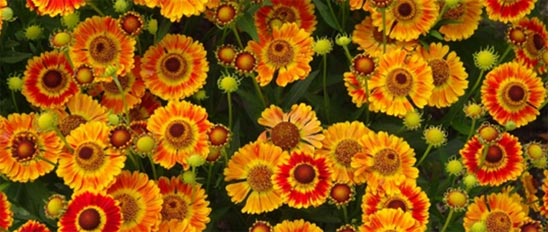

Diseases and pests
Perennial helenium is highly resistant to diseases, practically insensitive to pests.
- The main problem is viral diseases that hinder growth, distorting leaves and flowers.
- Another problem is gray mold, which can damage leaves and kill flowers. Infected shoots should be immediately removed and burned.
Attention! Do not dispose of damaged plant parts in compost.
Helenium care includes systematic plant inspections and pest control. When it comes to pests, the main enemy of helenium, especially young shoots, leaves and flower buds, is the snail. Natural enemies of snails:
Therefore, you need to try to increase their population. For frogs, make a small pond in a quiet place. Hedgehogs build a shelter from branches. The beetles useful in this fight will hide in the bark mulch. It is better not to use poisonous chemicals in the garden, which also poison beneficial animals.
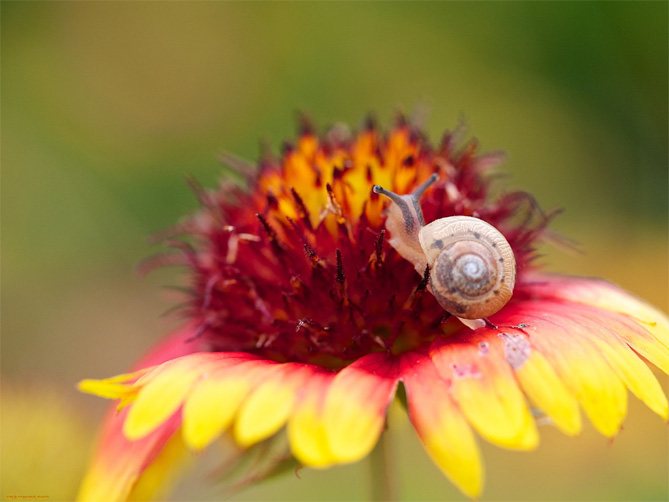

Snails do not like certain plants, for example:
By planting them in beds near heleniums, we protect valuable plants.
Fertilizer
The perennial flower helenium is quite gluttonous, it requires systematic fertilization. It blooms better in fertilized soil. Reacts well to feeding with natural fertilizers (compost). Apply the appropriate dose of artificial formulations - preferably a mixture intended for flowering plants.
Helenium care
It is easy to care for a flower; agricultural technology includes the following activities:
- Removing inflorescences. It is necessary to remove faded inflorescences in a timely manner, stimulating the plant to release subsequent flowers.
- Watering. Additional irrigation is needed during periods of drought.
- Weed removal. Plants grow quickly, so they usually do not require weeding. Systematic maintenance of the flower bed and removal of weeds after sowing, while the flower is small, is necessary.
- Garter. High varieties need support during the flowering period, under the weight of the flowers, the stems of the helenium often bend excessively.
Care features
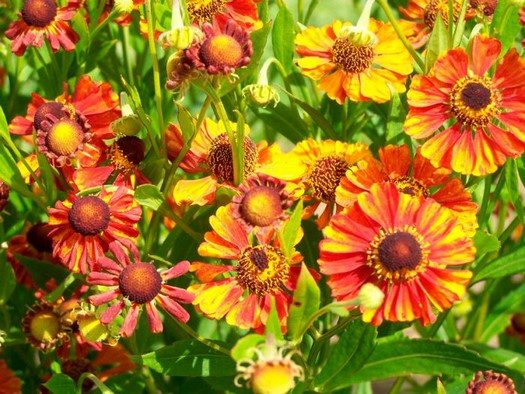

It is very easy to grow and care for such a plant, but you should study all the basic rules. It should be remembered that watering is very important for such a plant, since it reacts extremely negatively to a lack of moisture. After a long dry sultry period begins in the summer, helenium should be watered more often and more abundantly. However, it must be remembered that stagnation of water in the soil should not be allowed, in this regard, the land must necessarily have good water permeability. The soil should be periodically loosened shallowly, and all weeds should be removed in a timely manner. However, if you use mulching, then caring for such a plant will be much easier. During the summer, this flower must be fed 3 times, while using organic and mineral fertilizers:
- In May.For feeding, prepare a solution containing 10 liters of water and 1 large spoonful of potassium sulfate, urea and Effekton organic fertilizer. For 1 m 2, from 3 to 4 liters of this mixture are used.
- During flowering. For a bucket of water, 1 liter of liquid mullein is taken, as well as one large spoonful of Agricola-Fantasy and Agricola-7 each. In this case, from 2 to 3 liters of solution is taken for 1 m 2.
- In the last days of October. In a bucket of water, you need to dissolve 1 large spoonful of potassium sulfate and superphosphate. In this case, half a bucket of the mixture is taken for 1 m 2.
Read also: How to get rid of rats in a private house? SES recommendations
At the beginning of the budding period, you need to spray the plants with a solution that will help normalize the process of bud formation. To prepare the mixture, take 1 bucket of water and 10 g of Bud.
For more abundant flowering, you need to cut off those inflorescences that have begun to fade in time. At the same time, you can make the bush thicker and more branched by pinching the tops of the stems. Also, overgrown perennial plants need to be planted 1 time in 2 or 3 years. During the transplant, helenium multiplies by dividing the bush. Planting the plant is best in spring.
Diseases and pests
Such flowers are distinguished by their resistance to diseases and harmful insects. Very rarely, chrysanthemum nematodes can settle on the helenium, which harm flower buds and leaf plates. As a result, they turn brown and begin to dry out. Those parts of the plant that are infected should be cut and destroyed. For prevention purposes, it is necessary to add ground sulfur or slaked lime to the soil.
In the event that you provide the plant with optimal soil moisture, then it will not hurt.
Reproduction and planting
Often gardeners try to do flower propagation on their own. It's not hard.
Helenium multiplies in 3 ways:
Dividing the bush
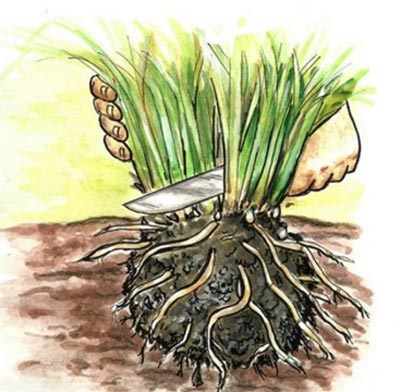

The best way to propagate helenium is by splitting the bush. The procedure is usually performed in the spring (March-April), every 2-3 years. Dividing the bush is very beneficial for the health of the helenium. In the spring, a plant is dug up with a lump of earth, the youngest, the outer parts are separated, used for planting, the middle is thrown away. Young plants will be more viable and provide a lot of new flowers.
Propagation by cuttings
A more difficult way to get young plants is to plant cuttings. Cuttings are prepared in spring in April-May, cutting off the upper part of the shoot. Shoots are germinated and rooted in a moist sandy-peat substrate. The seedlings take root within a week.
Seed propagation
Gelenium produces a large amount of seeds. It should be borne in mind that varieties that breed from seed usually do not retain the characteristics of the mother plant.
Care
The main requirement for caring for helenimum is considered to be regular watering, because the flower does not like overdried soil. On dry days, watering is carried out often and abundantly, but without stagnant water. Lack of moisture leads to drying out of the lower leaves. Surface loosening will improve the air permeability of the soil.
Top dressing is carried out 2-3 times per season. In May, add urea, potassium sulfate and organic sotav "Effecton". The dosage is a tablespoon per bucket. There should be 3-4 liters per square meter. In the flowering phase, they are fed with mullein and liquid Agricola. Here, 2-3 liters must be poured per unit area. In late autumn, helenium is fertilized with superphosphate and sodium sulfate. Consumption of the composition - 5 liters per square meter of the site. It is worth remembering that an excess of fertilizer leads to an increase in the growing season and the bush grows almost 2 times.
To obtain lush, branched bushes, pinching of the upper shoots is done. In June, it is recommended to prune the upper shoots to enhance branching and late flowering. The formation of a bush is especially important for single, border plantings.
To enhance budding, the plant is irrigated with the "Bud" preparation. The tall and fragile stems of the helenium need support.
Plants need to be planted every 2-3 years. The procedure is carried out in the spring with simultaneous vegetative propagation by dividing the bush. Sockets are easily separated and quickly take root in a new place. The lack of division leads to freezing of outlets and depletion of the soil.
Preparation for wintering consists in cutting off the stems at a height of 10-15 cm above the soil. The root part is covered with moss and sawdust. In snowless winters and in severe frosts, they are additionally covered with lutrasil.
Bud
Application in landscape design
Bright autumn helenium will decorate every flower bed. Flowers are called "hot" because they bloom in the colors of autumn: orange, rusty, red, yellow and their shades. Peduncles reach a considerable height, much higher than a meter, due to which they dominate in compositions. However, they need to be supported, tied up. Looks beautiful in combination with other naturalistic tall summer flowering perennials:
- rudbeckia,
- asters,
- yarrow,
- chrysanthemums,
- bouquet hydrangea,
- larkspur.
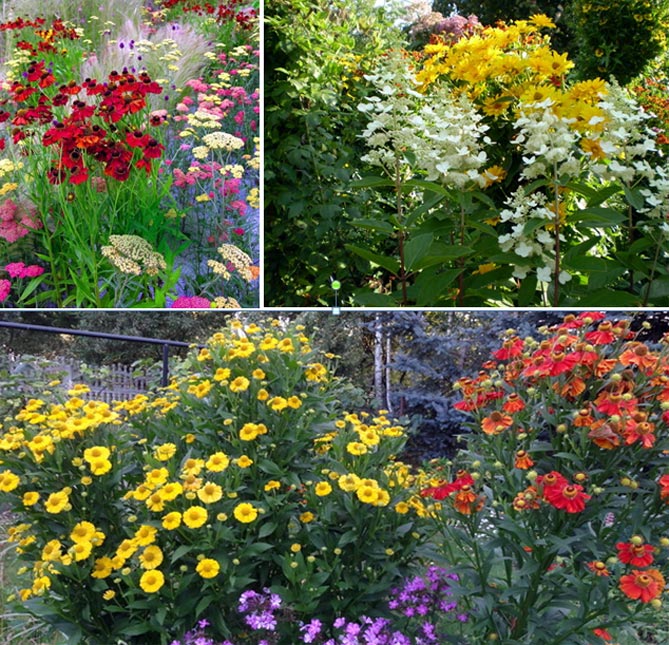

Bright, tall bushes work well against a white wall or openwork fence. Due to the tendency to expose the lower parts of the shoots, especially in drought conditions, it is advisable to plant them in the company of other, lower plants that cover the unattractive bare shoots. Garden geleniums are great plants for cut flowers.
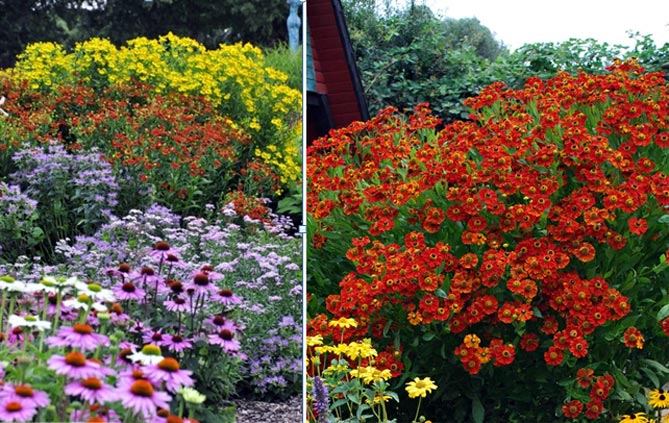

Choosing the right plants in your neighborhood guarantees compensation for flowering from July to October, when many perennials disappear. This should be taken into account when planning the plantings for the next year, because geleniums return to the gardens very often.
Flowers look beautiful in English, naturalistic or rustic gardens, but they can be used successfully in other garden styles.


Depending on the height of the bush, the planting method changes:
- High varieties of gelenium are ideal for top-floor flower beds and go well with asters, rudbeckia, phlox. You can create interesting, multi-group decorative combinations along walls, fences.
- Low varieties can be planted at the beginning of the bed, combining plants with catnip, daylilies, yarrow, ornamental grasses, salvia, low asters.
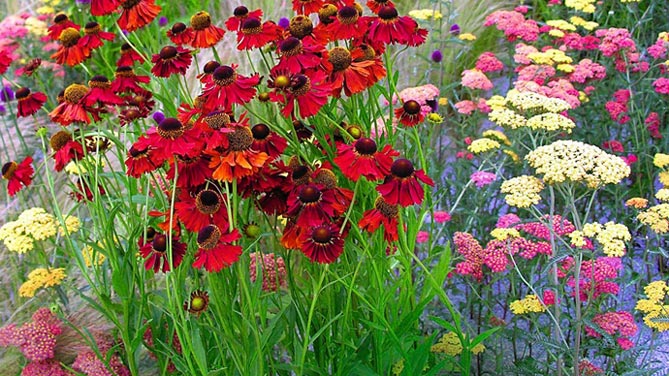

Geleniums bloom in autumn colors: orange, red, yellow and their shades. They are a beautiful and magnificent garden perennial with dazzling petals and bulging baskets, most of which include many garden giants. They are not only tall, but also very stable. The peak of flowering is observed in summer in July-August, the flower continues to be attractive until late autumn. They have many advantages because they tolerate unfavorable growing conditions and reward gardeners with beautiful flowers for a long time. Gelenium is loved not only by gardeners, but also by pollinating insects.
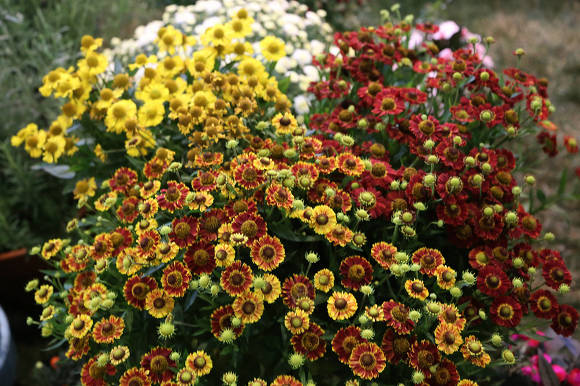

The name of this Compositae plant comes from the Greek word "helios" - the sun. The homeland of the Geleniums is North and South America; 39 species are known in nature, including annuals and perennials.
In culture, perennial species are grown - these are decorative, winter-hardy, unpretentious plants. Their main advantage is that they bloom profusely in late summer and autumn, when many plants are already fading.
Autumn Helenium (Helenium autumnale) is a perennial plant that originates from humid places, therefore its root system is poorly developed and is located in the upper layers of the soil. The plant is tall, 80–150 cm. The bushes have a columnar shape. Stems are numerous, straight, thick, strong, woody, leafy along the entire height of the stem. Leaves are light green, sessile, medium-sized, with a finely toothed edge. In its upper part, they branch strongly, each shoot ends with a flower-basket 3-5 cm in diameter.Each stem can have up to 15–20 flowers, and up to several hundred flowers bloom on the entire plant. Flower baskets are yellow, reddish, maroon with various shades, the tips of the reed flowers are yellow. Blooms from late August to late autumn. The autumn helenium bush consists of independent annual shoots with a developed root system. Small (2–5 cm) shoots overwinter in the form of shortened stems, each of which has independent roots. The bush increases in volume due to the buds that arise by the end of summer at the base of the mother's shoots. In old plantings, regeneration buds develop on the soil surface and therefore can freeze out in a harsh winter. To prevent this from happening, it is necessary to add peat or humus to the old bushes every year.
External characteristics
Autumn helenium is quite high (up to 160 cm); stalks are strong, branching, woody by the end of autumn. The leaves are small, light green, serrated at the edges. Baskets are chamomile-shaped, with a convex middle, 3-6 cm in diameter. The edges of the petals are curly, as if cut with scissors. Flirty to the side, they resemble a ballet tutu. The core of helenium is convex, during flowering it is covered with bright yellow anthers and takes on a spherical shape. On each stem of the plant, 15-20 flowers bloom at the same time in its upper part. Their yellow-orange palette fully corresponds to the current season and fits perfectly into the landscape of autumn days.
Growing helenium autumn
Growing conditions... Gelenium grows well in lighted areas with fertile and sufficiently moist soil. In one place, geleniums can grow for 3-4 years. After this, a transplant or division of the bush is required, since the flower baskets become smaller and bloom weakly.
Reproduction... The bushes should be divided in the spring; when dividing, adult bushes disintegrate into many individual specimens.
When seed propagation, the seeds are sown in the spring, after one pick in the phase of 2-3 true leaves, the seedlings are planted in the ground in a permanent place. Young plants bloom for 2 years.
Care behind the helenium is uncomplicated. In the spring, at the beginning of the shoots regrowth, it is necessary to feed the plants with nitrogen fertilizers, then apply mineral fertilizers 1-2 times more during the growing season. Weeding, loosening, mulching with peat. In hot dry weather, abundant watering is required.
Helenium hoopesii (Helenium hoopesii), or early autumn, grows at home in rocky mountains, in culture it has powerful and strong roots that go deep into the soil. Stems are strong, thick, low-leafed, branched in the upper part, during flowering they reach up to 1 m in height. Basal leaves are large, oblong-lanceolate, collected in a rosette. The stems and leaves are covered with a mealy bloom on the underside, which makes the plant very decorative. Flower baskets are orange, ligulate flowers are narrow and long. Baskets are collected in large graceful inflorescences in the form of an umbrella. Helenium blooms in June-July and blooms for 25-30 days.
Agrotechnics
Growing helenium consists in planting and caring for it in the open field. The agrotechnology of this plant includes the following stages: reproduction; landing; Care Each of them is important for the plant and requires some knowledge.
Reproduction
Reproduction of helenium is carried out in two ways:
- seed;
- vegetative.
Seed propagation is carried out in two ways. At the first, seeds are sown before winter on a prepared bed in September before the onset of stable frosts. Placed in the ground, they overwinter well.
The second method is seedling. Seeds are sown in February superficially in the snow, while stratification is carried out: they are placed in the refrigerator for a month and a half. After that, the container is transferred to light for seedlings at a temperature of 18-20 degrees. In the future, they are grown, like seedlings of other plants.For example, after the appearance of the third true leaf, the seedlings dive into separate pots. They are planted in open ground after the threat of recurrent frosts has passed.
Attention! Helenium seeds have a low germination rate, in the first season only 60-70 percent, over time it drops even lower!
Vegetative propagation is also carried out in two ways: by dividing the bush and by basal rosettes. The division of the bush and the transplantation of parts are carried out in one day. Helenium can be transplanted both in the fall after flowering and in the spring after germination.
Advice! After four years, transplanting the bush to another place is required. Otherwise, the plant thickens too much and loses its qualities, in particular frost resistance. In addition, the long stay of the plant in one place depletes the soil.
The second method of vegetative propagation is the transplantation of basal rosettes. The fact is that, as mentioned in passing above in the text, a helenium bush is a set of separate shoots with their own roots. So in the root zone on the stem, some buds give life to new plants, they look like small rosettes. During the winter, the stem together with the root die off, and the tiny replacement shoots overwinter perfectly under the snow. Separating them from the shoots, and laying a new bush.
Landing
Further cultivation of helenium takes place in the open field in a flower bed or as a tapeworm in the middle of the lawn. If you plant them in a composition with other flowers, then it is best to place these flowers in the background due to their elevation above their neighbors. When choosing a single location, be prepared for frequent watering of the bush, as such a location is more illuminated and dried by the sun.
Advice! It is not for nothing that Gelenium has one root with Helios - the sun god. It should be placed exclusively in a place illuminated all day long! In some shade, heleniums grow longer to the detriment of the size of the flowers.
The distance between the bushes with a solid planting of helenium is maintained from 50 to 80 centimeters, depending on the variety. The best landing time for central Russia is the end of May or the first decade of June; in other regions, the dates move in one direction or another, the main thing is that there are no frosts. If there is a likelihood of cold matinees, the plants should be covered with a film or covering non-woven material.
Geleniums prefer neutral and well-fertilized soil. When preparing the pit, keep in mind that you cannot bury the seedlings below the pot level.
Advice! When planting seedlings in a permanent place, spill an earthen ball abundantly for faster survival of the plant.
Care
Geleniums are quite unpretentious plants, and caring for them is simple. It is necessary to monitor the condition of the soil, preventing it from drying out. To reduce moisture evaporation, soil mulching is used. It is best to do this with fine-grained materials, for example, peat or compost.
In the dry period, if necessary, rare but abundant watering is carried out, bringing at least 10 liters of water under the bush.
During the season, it is advisable to make three dressings:
- Spring. It is carried out after the snow melts, it serves to enrich the soil with nutrients during the initial period of growth. It is best to carry it out dry, by adding compost or humus to the root zone. Dried chicken droppings or mullein can be used.
- Summer. It is carried out with herbal infusion before the flowering of the bush.
- Autumn. After cutting off old shoots, the soil is covered with a layer of organic matter. By rotting, it will provide food for soil microorganisms, and at the same time will cover the emerging rosettes of new helenium sprouts.
Pruning
When growing geleniums, pruning is carried out every autumn, cutting out completely all faded shoots almost flush with the ground, while trying not to damage the young sockets.
In addition, partial pruning of faded buds is carried out, this event brings new flowers to life and prolongs the flowering period of the bush.
When to plant
Planting dates depend on the growing method and climatic conditions in the region. Seeds in the seedling method are best planted in the second half of February, so that by the end of spring frosts and snow melt, young plants are ready for transplantation.
In open ground, helenium can be planted starting from mid-April in the southern regions, in the north you need to wait for the beginning or mid-May. The main condition is the absence of snow on the site, as well as the achievement of a stable warm temperature during the day at a level of 10-12 ° C.
Gelenium pests and diseases
An unpretentious character and strong immunity allows helenium to withstand many misfortunes and diseases. However, some of them still pose a great danger to him. For example, you can take chrysanthemum nematode, the vital activity of which is accompanied by damage to leaves and flower buds. You need to deal with such a problem quickly and radically, cutting off and burning the affected areas. Preventive measures include adding a small amount of hydrated lime to the soil composition. If we are talking about the prevention of fungal diseases, it is enough to provide the flower with competent watering and not overdo it with moisture.
The high moisture content in the soil contributes to the rapid reproduction of fungal microorganisms and the formation of putrefactive processes. Be careful and try to properly care for the plant in order to prevent such irreparable consequences.
How to grow and plant seedlings
Seedlings are grown using seeds. The grains are harvested from the mother bush or bought in flower shops. Gelenium hybrid varieties will not produce the same flowers from harvested seeds, so they can only be purchased.
Timing
Seedling preparation begins in April. At this time, the first frosts had not yet receded. 2-3 weeks after planting, the grains will sprout, which require appropriate care.
Seedlings are ready for planting, usually in mid-June.
Seed preparation
The seeds are soaked in warm water for a couple of hours. Then dipped in a solution of potassium permanganate for 1-1.5 hours. Dry them on dry gauze and start planting. Seeds are harvested in the fall from their own plants or bought in flower shops.
How to plant
Before planting, prepare containers with a volume of 250 ml and soil. Peat cups are convenient to use, they are immersed in the ground entirely, they disintegrate in the soil.
The soil is bought in flower shops or taken from the site. For homemade soil mix:
- 1 part peat;
- 3 parts of humus;
- 1 part sand.
For planting seeds, take a common large container. It is half filled with soil. Seeds of helenium are sown and covered with soil. Cover with foil on top to create a greenhouse effect. The pot is transferred to a warm place and periodically ventilated. After the sprouts appear, the film is removed. When the seedlings form 2 true leaves, they are seated in separate boxes.
See also
Is it possible to dig up verbena for the winter, how to keep it at home until springRead
Temperature regime
The seedlings are kept at a temperature of 20 ° C. 2-3 days before transferring to the ground, the seedlings are taken out to a cool place for hardening.
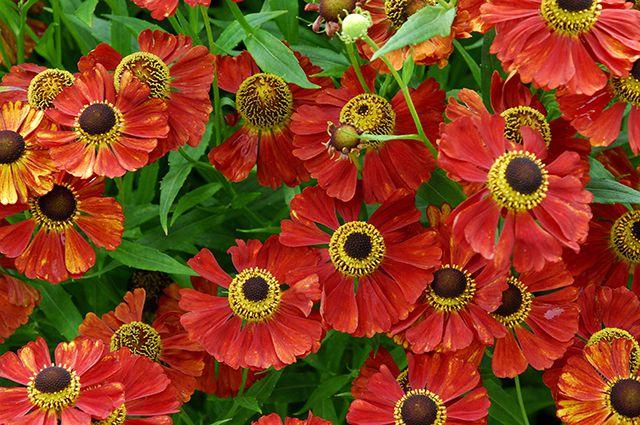

Important! Seedlings should not be exposed to frost at night, if they are present at night, then the planting is postponed to a more favorable period.
When and how to plant outdoors
The seedlings are transferred to open ground, when 3-4 true leaves are formed on the shoots. This time falls at the end of May or the beginning of June. When planting, there should be no night frosts, and the soil should warm up to 10 ° C to a depth of 10 cm.
Landing in open ground is performed as follows:
- In the prepared area, holes are made with a depth of 15 cm and a diameter of 10 cm.
- 2 cm of the drainage composition is placed on the bottom.
- Pour 200 ml of warm water.
- Transfer the seedling to the ground.
- Sprinkle it layer by layer with soil, compacting each layer with your hands.
- Sprinkle with warm water.
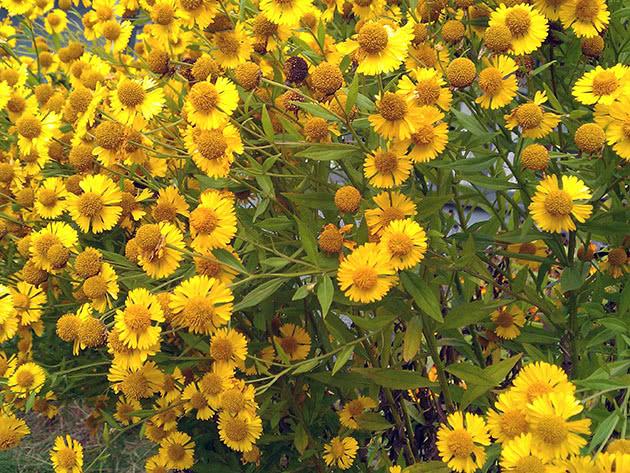

The flowering of helenium grown from seeds begins after 2 years of the growing season.
Combining helenium with other plants
Gelenium in landscape design can not only act as a constituent part of the composition, but also "single-handedly" decorate your garden. For example, tall heleniums are great for single plantings against the general background of the site.
In addition, tall varieties are well suited for decorating fences, or creating "hedges". If you are growing undersized varieties, they can be used to decorate curbs and garden paths. When breeding tall and short geleniums, they can be combined with roses, chrysanthemums and bells. Together, these flowers will create a wonderful ensemble of grace and simplicity. Low-growing varieties look great in a company with forget-me-nots: the combination of warm and cold shades will add a little mystery to the design.
Did you know?
Cut gelenium buds do not bloom in water, which should be taken into account when decorating the decorations.
Description of the plant
Gelenium is a genus of herbaceous annuals and perennials. The flower was first discovered in North America, where it still grows wild today. According to legend, the plant was named Helenium in honor of Helen the Beautiful, because of whom the famous Trojan War, described by Homer, began.
The plant has a strong erect stem, its height varies from 70 to 170 cm.Along its entire length, oblong dark green leaves up to 7 cm long are alternately located.The aerial part of the gelenium annually dies off together with the rhizome, only a few growth buds remain, it is they who revive bush next spring.
Flowering may differ in terms of time depending on the variety and species. Flowers usually form in early summer and last throughout the season. Each flower is represented by a small basket, which is framed by corrugated bracts, painted in bright shades of orange, red, pink and even purple. At the beginning of autumn, fruits are formed in the form of achenes with a small airy tuft.
Helenium care
Caring for helenium in the open field is reduced to watering, weeding and fertilizing. Lush bushes with bright flowers do not cause much trouble to the owners. However, plants are very fond of water. They need to be watered several times a week. In intense heat every day. In this case, the water should be easily absorbed into the soil, and not stagnate at the roots. In order for the air to penetrate the roots of the plant, it is necessary to periodically loosen the soil, breaking the crust on the soil surface.
Regular pruning is necessary to form a beautiful lush bush. As they grow, the shoots are pinched to stimulate branching. Immediately after wilting, the flowers must be removed, then after a while flowering will resume. Large bushes can lie down from strong gusts of wind and rain, so it is recommended to tie them up.
Every 3-4 years, a heavily overgrown plant is divided into parts. In autumn, all dried vegetation is cut to the ground, and the roots are insulated with fallen leaves, moss and sawdust to a height of about 10 cm.
Growing features
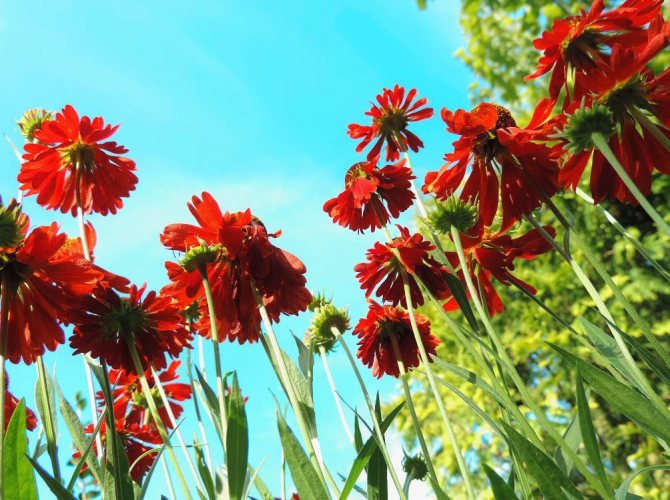

Gelenium is distinguished by strong immunity and resistance to diseases and pest infestation. Problems are usually noted only if the rules of care, agricultural cultivation techniques are not followed. The most common culture is affected by chrysanthemum nematodes.
The pest infects leaf plates, as well as flower buds. Leads to wilting of the plant and its death within only 1 month. If an infection is found, it is necessary to remove all affected parts of the plant, and then burn them.As a preventive measure, planting treatment with slaked lime or colloidal sulfur is used. Spraying is recommended twice a season.
Gelenium is a real decoration of the site. Thanks to the bright and rich color of the buds, the plant fits into any design, and the variability of the varietal diversity allows the crop to be used for a variety of purposes. The flower requires minimal maintenance, it can grow even in adverse conditions. When growing, you should competently approach the choice of a site, observe the irrigation regime and apply top dressing according to the scheme.
Varieties of gelenium: photo
Seed collection and wintering
Despite the fact that gelenium seeds are easy to find in modern shopping centers, they can also be collected by hand.
If you decide to collect seeds from your flowers for the purpose of reproduction, you need to do this immediately, since they will simply rot during the period of autumn showers. Dried and darkened inflorescences indicate the degree of readiness of the seed material for collection.
The storage area for seeds must be dry. You need to store them in a linen bag or cardboard box.
It's important to know
: most of the professional breeders and amateur flower growers still prefer the vegetative method of reproduction due to the low germination of seeds and the loss of the "parental" properties of the plant.
Competent preparation of plants for winter is a guarantee that next season the bushes will delight you with the beauty and splendor of flowering. You need to make a minimum of effort - mulch the beds with helenium plantings with peat, humus, sawdust about 5 cm thick or lutrasil. You must first cut off the stems, leaving hemp 10-15 cm high.
At the end of summer, when most of the ornamental plants and flowers have already faded, helenium explodes with fireworks of spectacular, colorful inflorescences that can delight even on the darkest day. An indisputable advantage is its long flowering and unpretentiousness.
How to grow helenium, see the tips in the following video:
Gelenium is a herbaceous plant with beautiful, multi-colored chamomile-like flowers. They have bright, curved petals and a strongly swollen lush core. The beauty of the plant is compared to Elena the Beautiful herself, from whose name it got its name. The helenium flower belongs to the Astrov family. His homeland is the west of North America. Today there are many types and decorative varieties of striking beauty, which allow you to turn the garden into a continuous varied flower garden. Observing simple rules of care, it will be possible to quickly achieve spreading thickets and lush flowering.
Growing from seeds
The adherents of growing helenium rightly recognize the fact that the best way is to divide the sockets. But you can also sow it with seeds. It is important to consider that in the northern zones with a cold climate, it is better to use seeds of zoned varieties.
You can sow seeds in the fall directly into loose, fertile soil with the addition of organic and mineral fertilizers. With this method of sowing, the flowering time of the plant may be postponed to the next year, or later.
The low germination of seeds, especially freshly harvested ones, dictates the decision to grow seedlings of helenium flowers in room conditions. Sowing seeds is carried out in February-March in boxes with prepared moist soil, covered with glass or plastic wrap.
The temperature for germination should be + 18-22 degrees.
One must not forget to regularly water and air the seedlings upon emergence.
At the age of 2-3 true leaves, the plant must be dived. They are planted in a permanent place in fertilized soil at a distance sufficient for further root formation and growth of seedlings.
Further care for helenium
Around the third year of life, heleniums should be planted, otherwise they can get tangled in roots, as a result of which they begin to weaken. Planting and division is carried out in the spring, every three years. In May, plants are fertilized for the first time.
The second dressing should be before flowering, when the buds began to appear. The third time the plant is fed after its flowering. Geleniums practically do not get sick and are not afraid of pests. To get sprawling bushes near the gelenium, gently pinch the tops. Since the plant loves light, they contain it in a sunny, brightly lit place.
Gelenium has a fairly extensive characteristic. This plant is a representative of the Asteraceae family and has been found in culture since 1635. However, the flower was first described in the work of Carl Linnaeus in 1755. All plants of this species can have completely different heights of the bush, and depending on the variety, it varies from 30 to 150 cm. The colors are always made in warm colors and can be either one-color or two-color and even variegated. Lanceolate leaves.
The most widespread helenium received in North and Central America. Now in the world there are about 30 species of perennial helenium, the cultivation of which is not particularly difficult.
Did you know?
People believe that the plant got its name in honor of Menelaus's wife.
—
Helena, who became the cause of strife and war between Troy and Greece.
The use of gehlenims in garden design
Geleniums are used in group plantings to create bright flower spots of late summer and autumn flowering and in mixed beds. Cut inflorescences remain fresh for up to 15 days.
In many gardens and flower beds such a beautiful and sunny flower grows - helenium. According to legend, this lovely plant, delighting with its flowering on the eve of the beginning of autumn, received such a unique name in honor of the beautiful Elena, wife of Menelaus, whose charm was so admired by the admirer of Paris. Probably, the golden tone of this flower resembled the color of Elena's golden curls.
Description and characteristics
Flowers helenium (Latin Helenium) are ubiquitous in the North and South continents of America, as well as in Canada.
Wild flowers are often found in sunny glades of evergreen and deciduous forests. The inflorescences-baskets of the heads always look at the sun and their name is from the Greek word "helios" - the sun.
According to legend, it is believed that the Helenium acquired its name in honor of the beautiful Helena, the wife of Tsar Menelaus, with whom the beginning of the Trojan War is associated. This character is familiar to us from Homer's ancient Greek poem Iliad.
The genus helenium has about 50 species and subspecies of annual and perennial flowering plants.
The value of decorative perennials that bloom at the end of summer is that they are not demanding to care for.
The most common among them is autumn helenium with yellowish inflorescences. All other varied varieties originate from it.
The originality of the plant lies in the non-wintering rhizome. The flower stems die off together with the roots, at the base of which there are already developed numerous small rosettes.
In the spring, having survived the harsh cold weather, they all give new shoots and clumps of helenium plantings grow very quickly. The first cultivated variety, Gelenium, was bred in 1909 by the American botanist Maurice Pritchard. It was named "Riverton Beauty".
The ornamental plant was 1.2 meters tall with yellow-brown inflorescences. Very quickly, other, new varieties of various colors from yellow to orange and red began to appear.
Cultivated flower varieties are now cultivated almost all over the world. This is facilitated by their resistance to frost and drought, they are unpretentious to growing conditions.
Beautifully flowering perennials reach 70-160 centimeters in height.Multiple strong erect trunks branch out in the upper parts, covered with delicate hairs and leaves. Stem leaves are oblong with small teeth of dark green color.
note
: the root system of the plant is developed with a large number of adventitious roots that grow in the surface layer of the soil.
The inflorescences of the plant are large, can reach a diameter of up to 8 centimeters. Baskets consist of small tubular flowers of yellow-brown shades, forming a convex knob in the center. The so-called petals of various colors are located around the circumference of the bump. Their color range is quite diverse: from pale yellow to piercing red.
Geleniums are sun-loving, which justifies their name. Plants love fertile soils, with the addition of organic and. Watering is necessary regularly, but drought is tolerated calmly by them. Flowers are practically immune to infections.

